The history of the excavations
The Shrine of Silvanus is situated in the south-west corner of the House of the Millstones: room 25 (max. w. 2.06, max. d. 6.50), to the north of the tiny room 24 that can be entered from Via di Diana. Many rooms of the House of the Millstones were unearthed for the first time in 1870, under the direction of Pietro Ercole Visconti. Room 25, the Shrine of Silvanus, must have been investigated in that year as well. In the Giornale di Roma of May 16th the find is reported of a painting of Silvanus. It was a large painting of Silvanus "with the usual attributes", found "near the entrance" of the building. On it EX VISO was read, written with large purple letters. It had a graffito with a date, "possibly from the time of Maximian". In 1887 the words EX VISO were published in the corpus of Latin inscriptions (CIL) by Dessau, who remarks that the painting can no longer be found, and that not even Carlo Ludovico Visconti and Rodolfo Lanciani, who had been present at the excavations at the time, knew anything about it. Now on a painting of Silvanus found in the shrine during the First World War a graffito with the consular date 215 AD was found by Wirth in 1928. It is hard to believe that the building had two paintings of Silvanus with a date. The words EX VISO were never seen again, but they can easily have disappeared if they had been applied "dry". The "disappearance" of the painting could be due to the filling of the room with earth after the 1870-excavation.
This is not the only confusing situation. In 1914 a layer was found in the shrine described as "incendio o materiale incendiato", of varying height, with an average height of one metre. In this layer a large number of objects was found, mainly fragments of utensils and tools, and a marble statuette of a Lar. The statuette was found between the altar and a large niche in the south wall of the Sacello, the other finds according to Guido Calza near the entrance of the shrine. Now the Visconti's did not work with the accuracy of modern times, but they will not have missed the statuette. And what is more, the statuette, with a preserved height of 37 centimetres, was found at a distance of only approximately 80 centimetres from the painting of Silvanus, at a height of approximately one metre, that is some 25 centimetres above the bottom of the painting. If the painting was found, how could the statuette have been overlooked? But the story becomes more complicated.
Rodolfo Lanciani wrote three times about the shrine. In 1889: "La découverte d'un magasin d'objets d'art, avec plusieurs douzaines de statuettes en bronze, faite en 1870 dans la Via delle Pistrine ..." (Mélanges de l'école française). Again in 1889: "In the spring of 1870, the last campaign led by the Viscontis, a room was discovered on the west side of the Via delle Pistrine containing sixty or seventy statuettes of bronze, presumably the property of an old dealer in works of art" (Notes from Rome). And then in 1909: "In the excavations of 1858 led by Visconti a house was discovered in the "Strada delle Pistrine", in the lararium of which some fifty bronze and silver statuettes of domestic gods were lying partly on the steps of the altar, partly on the floor" (Wanderings in the Roman Campagna; the year 1858 must be an error).
The words "on the steps of the altar" are a bit strange, because a simple, rectangular altar can be seen in the shrine. The answer to this problem lies perhaps in Raffaele Finelli's remark "tutta l'ara ... fu anche rialzata più tardi facendovi sopra una costruzione molto andante". It is particularly striking however that the find of the statuettes is not mentioned in the reports from 1870. Here 14 statuettes from the building are mentioned, all found before April 5th (we do not learn where and in what context), whereas the painting is mentioned for the first time on May 16th. The end of the investigations is reported on June 3rd. Why is Lanciani the only one to report this spectacular find?
The answer probably partly lies in a theft. It is hinted at by Raffaele Finelli, who says that the first excavators were "scavatori poco scrupolosi e gli oggetti rinvenuti non tutti raggiunsero i musei papalini". Jérôme Carcopino goes into more detail, quoting Lanciani: "Une circonstance qui ne dut pas engager C.L. Visconti à donner à ses fouilles dans ses parages une trop bruyante publicité, ce fut l'affaire G..... A 83 m. à l'Est de l'angle Est du temple, et à 21 m. au Sud "fra gli avanzi di edificio privato incominciati a scavare sul principio di quell'anno (1870) ... si rinvenne una quantità prodigiosa di sculture figurate ed ornamenti in bronzo quasi che una o più delle officine tornate in luce avessero appartenuto ad un fonditore di metalli. Molti di questi piccoli oggetti d'arte furono involati (G.....) e venduti a Napoli" (Notes Lanciani). Ce surveillant indélicat est nommé en toutes lettres dans les notes de M. Lanciani: il se déroba, par la fuite, aux poursuites judiciaires". The turbulent political developments in 1870 will also have played a part.
The building periods
Rooms 24 and 25 (the shrine) were installed in the southern part of an alley or corridor between the House of Diana (I,III,3-4) and the House of the Millstones. Two Antonine phases are found here. The northern part of the east wall is Hadrianic, the southern part Antonine. The southern end of the latter part was rebuilt in the Antonine period. The west wall, containing two brick piers, is Antonine as well. Set against the southern part is another Antonine wall. The latter wall and the rebuilt part of the east wall form an entity and create the southern entrance to the alley.
In the lateral walls of room 24 and directly to the south of the dividing wall of rooms 24 and 25 are two F-shaped grooves, one in each wall, meant to receive beams which presumably blocked the alley for the general public or for animals. The nature of the obstruction indicates that for some time no rooms were installed in the southern part of the alley on the ground floor.
Beamholes can be seen in the west and east walls of rooms 24 and 25 (one of these in Severan masonry). Their tops are at the average h. 3.65, the normal height for the Hadrianic and Antonine periods in the rest of the building. The beamholes in the west wall of room 16 are passing through the wall, suggesting that there was a roof over room 24 during the first Antonine phase. The secondary west wall can only have been meant for the insertion of beamholes: apparently no permission was given to insert them in the House of Diana. The existence of an upper floor in the second Antonine period is indicated by the presence of a mezzanine-window over the entrance from Via di Diana. There was no door on the first floor in the dividing walls of rooms 16 and 24, and 17 and 25. Apparently then the mezzanine-floor was reached along a mezzanine-staircase or ladder in the alley.
Plan of the shrine.
Red: Hadrianic; yellow: Antonine.
Brown: Severan; blue: undated.3D-view of rooms 26 (with a basin; left), 25 (center) and 24 (right).
From the north-west.
Bakker 1994, fig. 20.Room 25 in its present form was created during the period c. 210-235 AD. The space between the two Antonine brick piers of the west wall was filled in. Against the northern pier a wall was set at a right angle, leaving an entrance 0.96 wide. The western half of the door in the Hadrianic east wall was filled in. In the filling are two slit-windows, providing light to room 17. Later in the Severan period the eastern half of the doorway was filled in as well. The slit-windows were thus blocked, but not filled in, so that two niches resulted. The dividing wall between rooms 24 and 25 has been so heavily restored that its masonry cannot be dated. It was set against the west wall and into the east wall of the alley. In the eastern part of the south side was a 0.75 wide floor-niche, which was later filled in. In the west part of the north side are two wall-niches, one 0.41 wide, the other measuring only 0.15 x 0.12 x 0.15. The former was later filled in.
After the Severan period the eastern half of the doorway connecting rooms 24 and 16 was blocked, in two phases. In room 24 a recess or floor-niche resulted, on the back of which slight traces of red paint have been preserved. In the upper right corner of this niche was a second, small wall-niche.
Overview of the paintings and the floor-mosaic in room 25
The oldest layers of plaster can be found on the north, east and west walls, one on the north and east walls, two on the west wall, with traces of red paint on the first (together: layer 1). The layers are very thin.
A superimposed, thick layer is found on all walls (layer 2). Next to the larger niche in the south wall a small figure wearing a tunica was depicted. Calza thinks this may have been a Lar. Not enough of the figure has been preserved for a reliable identification. Furthermore large rectangles were painted, on the west wall containing three "floating" figures: a bird, a gorgoneion, and a dolphin. On the southern part of the west wall Silvanus was painted (now in the storage rooms). He is a little over one metre high and standing in a frame. He was partly gilded and is holding a branch and a sickle-shaped knife. He is accompanied by a dog and standing next to an altar.
In 1994 I wrote that the painting was inserted in the layer, witness grooves. I deduced this from an irregular stretch of white plaster next to the painting, visible on a photo from 1915. This is contradicted however by a picture taken later by the ICCD (E040752, see below). It is more likely that only this stretch had been cleaned. There may have been a groove above Silvanus (see excavation photo B1112, below) for a wooden plank "supported" by two painted beam ends on either side of Silvanus' head. The plaster above Silvanus was painted yellow.
At least four later layers, all very thin, can be found. The oldest of these has several figures, which were originally red (layer 3). Later (immediately afterwards?) several colours were added (layer 4). Layer 3-4 is encountered first of all directly behind the entrance. On the west wall three horses and a male figure holding a sceptre or lance were painted. The attribute and the proximity of horses indicate that the figure, which has been preserved very badly, is a Dioscure. A horse and presumably the other Dioscure were painted on the opposite wall. On the southern part of the west wall, to the right of Silvanus, at least one figure was painted. All that has been preserved is the right arm, holding a lance or sceptre.
Top.
Remains of a Dioscure
on the west wall.
Bakker 1994, fig. 21.
Right.
Location of the paintings
and mosaic.
Bakker 1994, fig. 19.On the southern part of the east wall a row of figures was painted.
- The first of these is holding a sceptre or lance and wearing a mantle around the hips, whereas the upper part of the body is naked (the other arm and the head are missing). Calza, who for the most part saw layer 5 (now largely disappeared), which repeats layer 3-4 with only one exception, calls this a figure in the posture of the Augustus of Primaporta. Moormann points out that the figure represents a first century Emperor, whose identity will be discussed below.
The second, third, and fourth figure were correctly identified by Calza:
- Next to the Emperor is the small Harpocrates, holding a cornucopiae and touching his lips with one finger of his other hand.
- He is standing at the feet of Isis, who is holding a sistrum. Her other arm cannot be traced.
- The fourth figure is Fortuna, holding a cornucopiae and a rudder.
- Next to Fortuna is a figure with rudder and tessera, regarded by Calza as Liberalitas. Nicolet however has shown that Annona is depicted: the tessera is found as an attribute of Liberalitas, but she has a cornucopiae in the other hand.
- The next figure is male in view of its short mantle. In one hand is a cornucopiae, the other holds the mantle, not an attribute. Around the head was perhaps a nimbus. On the Aquari sarcophagus (Annona sarcophagus) a female figure can be seen, supporting a lighthouse with her right hand and holding her mantle with her left hand in a way very similar to our figure. She has been interpreted as the personification of Portus. The most natural interpretation of our figure is that it is Abundantia. She was associated with Annona on Neronian coinage and has the cornucopiae as attribute. The couple Annona - Abundantia would nicely balance Isis - Fortuna. But as has been said: the mantle of the figure indicates that it is male. The gender and the cornucopiae suggest it is a Genius, but of what?
- The final figure was called by Calza a figure in the posture of the lysippian Alexander the Great. Moormann has confirmed this identification. This figure is naked except for a mantle hanging down from a shoulder, and holds a sceptre or lance. It is not clear whether there is an object in the other hand. Around the head is a nimbus.The next intervention (layer 5) can be traced only on the southern part of the east wall and the outer north wall. The Emperor was, as far as can be seen, left unchanged. Harpocrates, Fortuna, Annona, and the Genius were repainted. Isis was replaced by a male figure, holding a patera in its right hand (a Genius?). Between the four central figures torches were painted, perhaps a reference to Ceres and grain. Another painting of Silvanus was seen by Finelli on the outer north wall, next to the entrance. According to him it belongs to layer 5. Finally a thin, white layer was carelessly applied (layer 6). It is a whitewash that is found frequently as a final phase on Ostian paintings.
On the floor of the room is a black-and-white mosaic, with the depiction of a figure that Calza identified as a victimarius, an assistant at sacrifices, holding an axe above his head. Aldrete has shown that the correct name for the figure is popa, not victimarius. He raises a hammer. At an unknown point in time a masonry altar was set on top of some object depicted in front of the figure.
The dates of the plaster and the floor-mosaic
Layers 1 and 2 are on masonry which according to Heres is from the period c. 210-235 AD. For layer 2 stylistic datings of c. 200 and 210 AD have been suggested. The painting of Silvanus is on Antonine masonry. It cannot be later than 215 AD, witness a graffito, discussed below. For this painting stylistic datings in the period of Commodus and of c. 210 AD have been suggested. Moormann opts for a dating of layer 2 and Silvanus in the Severan period. The masonry and the graffito narrow down the dating of layers 1 and 2 to the years c. 210-215 AD. The partial blocking with slit-windows of the door between rooms 17 and 25, dated by Heres to the later Severan period, can then also be pinpointed to these years, whereas the south wall of the room cannot be later than c. 210-215 AD.
The later phases are difficult to date stylistically. A parallel for layers 3-4 is offered by a fragment of a painting from the House of Hercules, on which the lower part of three figures has been preserved (ICCD E040753, see below). The figures bear a great resemblance to figures on layers 3-4, as to their shape, posture, clothes and colours. What remains of the first and third figure is almost identical to the lower parts of the Genius and Alexander the Great. The lower part of the central figure may be compared to the lower parts of Isis, Fortuna and Annona. For this painting dates in the second century and in the Severan period have been suggested. For layers 3-4 or layer 5 the later third or fourth century and a date of c. 240 AD have been suggested. For layer 5 Moormann suggests a date in the period Caracalla - c. 250 AD.
Layers 1 and 2
From the thin layer 1 no conclusions can be drawn. When layer 2 was applied the Sacello was equipped with an interesting ante-room. At 2.34 from the north wall is a vertical groove in the plaster of the west wall (1.5 cm. wide), next to which is a red band belonging to layer 2. At 2.13 from the floor it runs horizontally towards the north wall over a distance of 0.16. Then the groove and band continue vertically again. I suggest that a wooden partition was fastened in the groove. Rectangles and "floating" figures were painted to the south of the groove.
The reason for depicting Silvanus can be deduced from the words EX VISO, read on the painting in 1870. Apparently a deity (Silvanus himself or another deity) had appeared to someone in a dream and ordered the dedication of the painting. The shrine was regarded as a shrine of Silvanus, in view of the painting of this deity belonging to phase 5 on the outer north wall, next to the entrance: like a religious "shop-sign" it explains to which deity the room was dedicated. The back part of the room was the focus of the cult-room, as is indicated by the presence of Silvanus and by the large niche in the back wall.
Silvanus was one of the most popular deities of the Imperial period, but has never had state-temples and -feasts. He was a god of the woods and gardens, of live-stock, of the villa, and of boundaries. The knife and branch he is holding refer to the woods and garden, the dog sitting next to him is the guardian of the plot of ground. In Italy he was worshipped intensively by slaves and freed slaves, especially those of the Emperor. In Italy dedications were made pro salute domini, or dominae, or imperatoris; pro sua salute; ob libertatem; huic loco tutela; ex viso, ex iussu.
Layers 3 and 4
Of layers 3-4 three groups remain. First of all the four horses and the two Dioscures. Secondly the row of figures from the Emperor to Alexander. Thirdly one or more figures next to Silvanus.
The Dioscures and at least four horses were painted in the ante-room. The most southern horse on the west wall does not continue to the south of the groove with the presumed wooden partition, where very scanty remains of a superimposed layer are found. It appears that the continuation of the horse was on the wooden partition which was attached in the groove.
The Dioscures, the twins Castor and Pollux, were usually depicted with horses, who played an important role in their official worship. They were patrons of the equestrian order, and a sacrifice to Castor was the focus of an annual parade of the Equites (knights). They were furthermore patrons of the chariot-races in the circus. Ostia was the only place where the Romans continued the ancient relation between the Dioscures and sea-faring. The twins were here officially worshipped in their capacity of protectors of navigation. Each year on January 27th Ludi Castorum were held at Ostia - led by the Praetor Urbanus, later the Praefectus Urbi -, quite possibly involving horse-races. The Ostian temple, where the Dioscures gave oracles, has been identified: it is to the west of the so-called Imperial Palace, on top of the so-called Navalia. Few dedicatory inscriptions mentioning the Dioscures have been found in the western half of the Empire. In Rome depictions of the Castores were bequeathed to the mensores machinarii frumenti publici (the "machine-weighers of the public grain") in 198 AD. In Ostian dedications they are found together with Neptunus and Jupiter-Serapis. The relation with the sea is obvious in the former inscription. Serapis was sometimes worshipped as protector of shipping, but may also be related to the Egyptian grain.
Group two was opposite and most likely supplemented by group three. Of group three little remains: a figure with lance or sceptre next to Silvanus. Group two can be regarded as a separate unit, because the scene is framed by two rulers, an Emperor and Alexander the Great. The figures of group two were originally framed by bands, later covered by layer 4. The bands frequently intersect the figures and in that case presumably pass behind them. Some of the bands, both horizontal and vertical ones, have a slight inclination. Such bands and lines are found frequently on Ostian paintings from this period. Proposed explanations are carelessness, and economic or aesthetic motives. As to the total height of the figures, only that of Alexander is known (0.83), but from the size of the bodies of the remaining figures can be deduced that all had the same height, with the exception of course of Harpocrates.
As to the identity of the Emperor, Moormann points out that only during the first century AD, and especially during the Julio-Claudian period, were Emperors represented nude apart from a drape around the hips and sometimes over the shoulder, i.e. in heroic form, especially after death. What is seen therefore is an outmoded depiction, not of a living, but of a deceased Emperor. Here Augustus, the most praised and famous Julio-Claudian Emperor, immediately comes to mind.
The Egyptian goddess Isis was worshipped by the Romans as deity of plenty and nature, steering fate, helping men in various ways, as healer of the sick, and as protectress of shipping (Isis Pelagia, Isis Pharia). It has been thought that she protected the Emperor as Isis Augusta, but because her husband Serapis is called Serapis Augustus only once in inscriptions, whereas his relation to Emperors was much stronger than that of Isis, Augusta perhaps rather refers to her "reign". In Ostia and Portus, Isis was associated particularly with the large quantities of fiscal (Imperial) grain which were drawn from Egypt, and with the Alexandrian grain-fleet. One may compare an aureus from 215 AD, on which Isis is seen giving two ears of grain to Caracalla, who is wearing military dress, holding a spear, and subduing a crocodile. The Ostian temple, probably situated in the area around the Palazzo Imperiale, has not yet been found. The Isis-feast Navigium Isidis, celebrated on March 5th in relation to the opening of the shipping season, may have been held in Ostia. From the way in which Isis is depicted in the shrine it cannot be deduced in which capacity she is present. She was often depicted with sistrum and situla.
Aureus from 215 AD, showing Isis giving ears of grain to Caracalla, who is subduing a crocodile.
Obverse: ANTONINVS PIVS AVG GERM; reverse: P M TR P XVIII COS IIII P P.At the feet of Isis is Harpocrates, the young Horus, the child of Isis and Serapis. As usual he holds the horn of plenty, a reference to fertility and prosperity, whereas one finger of his other hand touches his lips (according to the Romans to ask for silence and attention, originally a child's gesture). In the Roman world he was a sunnaos theos only, and in inscriptions he is always found together with Isis.
To the right of Isis is Fortuna. She was primarily regarded as a benevolent power, as a goddess of luck and good fortune, rarely as the personification of blind fate or even a malicious power. She protected human beings and localities. She was often called Fortuna Augusta, guardian of the Emperor, whereas Fortuna Redux watched over the safe return of the Emperor from foreign journeys. In the shrine she is depicted in the way she is found most often: with rudder, indicating her control of fate, and cornucopiae, referring to the blessings she could bestow. Perhaps the rudder also refers to sea-faring. Other parts of ships, such as the prow or an anchor, could highlight this aspect.
The fourth deity is Annona, the personification of the food supply, especially the grain supply, of Rome. In her right hand is the tessera frumentaria, on presentation of which a restricted number of recipients collected free grain each month in the Porticus Minucia Frumentaria in Rome. In her other hand she holds a rudder, referring to the overseas transport of the grain.
The last figures are perhaps a Genius, and Alexander the Great. The latter and perhaps the former was provided with a nimbus, a symbol of heroic status and deification.
Augustus and Alexander the Great frame Isis, Harpocrates, Fortuna, Annona and the Genius. Thus the central and most important part of the scene is literally to be understood within the framework of the two rulers, exemplary rulers from the past in whose footsteps the contemporaneous ruler should follow. Depictions of illustrious men from the past could be found in household shrines. "Even today statues of Marcus Antoninus stand in many a home among the household gods", says a biographer of Marcus Aurelius (Denique hodieque in multis domibus Marci Antonini statuae consistunt inter deos penates). Suetonius presented a statuette of Augustus to Hadrian, who gave it a place amongst his household gods. The two lararia of Alexander Severus contained depictions of Alexander the Great, deified Emperors, Abraham, Christ, Orpheus, Achilles, Apollonius of Tyana, Cicero, and Virgil. It was a very small step to regard such men as exempla virtutis, which could even lead to association, imitation and identification. Thus we know that in the third century AD two Emperors emphatically evoked Alexander the Great as predecessor: Caracalla ("he thought that he must imitate Alexander of Macedonia", se Alexandro Magno Macedoni aequandum putabat; SHA Caracalla 2) and Alexander Severus ("he had himself depicted on many of his coins in the costume of Alexander the Great", Alexandri habitu nummos plurimos figuravit; "He would read, too, the life of Alexander the Great, whom he particularly sought to resemble", Legit et vitam Alexandri, quem praecipue imitatus est; SHA Alexander Severus 25 and 30). Three Emperors did so to a lesser extent: Gordian III, Philip the Arab and Gallienus.
With the help of the graffito mentioned above it can be shown that Caracalla is referred to. It is found next to Silvanus, in a tabula ansata: "Calpurnius, night-watchman from the centuria of Ostiensis, from the sixth cohors, during the reign of Caracalla, in the year of consuls Laetus and Cerialis, X". The year is 215 AD. The graffito was written by one of the vigiles (fire-fighters), who were stationed in the Barracks of the Fire Brigade. Calpurnius was, when he wrote the graffito, sebaciarius, night-watchman. This duty was assigned to the vigiles in rotation for a period of one month. The sebaciarii patrolled through the city at night with tallow-candles, on the look-out for fires, and probably acting as police. The X is in an ansa of the tabula and means votis decennalibus. Calpurnius therefore asked Silvanus to give Caracalla ten more years as Emperor.
Parallels for this graffito have been found in Rome. In 1866 a fire-station (excubitorium) of the seventh cohort was excavated in Trastevere. In and near its shrine 97 graffiti were found, most of which are from sebaciarii. The earliest dated graffito is from February 215, the last from March 245 AD. Some short graffiti mention only the name of a miles, frumentarius, or sebaciarius, while others simply record that the sebaciaria have been performed in some month (sebaciaria fecit mense ...). The longer graffiti of the sebaciarii are similar to that of Calpurnius. These contain the names of the sebaciarius, the centurio, the cohors, and the eponymous consuls, and end with sebaciaria fecit mense ..., or a similar statement. Apparently the patrols were not without danger, for sometimes it is stated that all had gone well (e.g. omnia tuta, salvis commanipulis). One graffito refers to the Genius of the watch-house. In a number of cases there is a plea for the welfare of the Emperor (e.g. salvo domino nostro) and the continuation of his government, sometimes expressed by writing X or XX in an ansa of a tabula ansata. Clearly the shrine in or near which the graffiti were found was in some way related to the cult of the Emperors.
It can be established that Calpurnius must have seen the added figures of layers 3-4 when he wrote his graffito. On the east wall, between the two former slit-windows, is the graffito "Marius, Anna, April 25th", followed by a leaf. A little below is written CERIALE, the name of one of the two eponymous consuls of 215 AD, which is also found in the graffito next to Silvanus. The handwriting shows clear similarities with that of Calpurnius' graffito, and it may be assumed that it was he who added the year to the day. The two graffiti on the east wall are now read on layer 2, but must have been written on and through layers 3-4, which have here disappeared: they are very hard to find and read, because they are very superficial; the graffito of Marius and Anna was written with large, regular and accurate letters, which presupposes legibility; the letters of CERIALE are much thinner and shallower than those of the graffito next to Silvanus.
COH(orte) VI (centuria) OST(iensis) IMP(erante)
AN(tonino) CO(n)S(ulibus) L(a)ETO ET CE
RIALE SEBARIVS
CALPVRNIVS, XThe graffito of Marius and Anna.
Text 0.11 x 0.22.
Bakker 1994, fig. 23.Top: the graffito of Calpurnius next to Silvanus (0.11 x 0.04).
Bottom: the graffito below that of Marius and Anna (0.08 x 0.015).
Bakker 1994, fig. 22.Layers 3-4 therefore have a terminus post quem non of April 25th 215 AD, and the Emperor referred to must be Caracalla. He had left for Egypt in 214 AD, at the age of 26. After arriving in Thrace he began to compare himself to Alexander the Great. Herodianus and Dio (Herodianus 4, 8, 1.2; Dio 78, 7, 2) inform us that "all of a sudden he became Alexander". He ordered the erection of statues that should show the likeness between himself and Alexander. According to the ancient historians such statues could also be seen in Rome, sometimes strange hybrid depictions of Caracalla and Alexander. He also referred to himself as "Augustus of the East". Some people in the House of the Millstones had apparently acted upon Caracalla's orders.
The figure next to Alexander the Great could be the Genius Augusti, especially if there really is a nimbus around his head. The Genius Augusti and imagines of the Emperor frequently formed part of the contents of house-chapels, from Augustus onwards. Thus the Genius of Octavianus is presumably painted in a niche in building IX 9, 13 in Pompeii. Below the niche the graffito EX SC was read, which must refer to a senatusconsultum of 30 BC, ordering wine-offerings to (presumably the Genius of) Octavianus. Caracalla was perhaps depicted next to Silvanus (group three).
The deities in between Augustus and Alexander may refer to one or more donations from the Emperor. There is no central deity on the east wall, so that the figures in between Augustus and Alexander are to be interpreted either as a "story", from left to right, or as juxtaposed figures, which may or may not be interrelated. If it is a "story", Annona suggests that Isis and Harpocrates refer to the Egyptian grain which was distributed by the Emperor (for the protection of the transport of the grain the Dioscures are better candidates). The presence of Fortuna however presents a problem, because the reference to good fortune in between Isis and Annona does not contribute anything to the "story". Apparently then we see a juxtaposition, and a reference to either different donations, or aspects of a single generous deed. As to Fortuna, the reference to good luck is so general that she cannot symbolize a specific donation. The frequent association of Isis and Fortuna comes to mind, a pair balanced by Annona and the presumed Genius Augusti.
The most obvious explanation for the deities is that they refer to the supply of grain by the Emperor. Isis and Harpocrates refer to the grain imported from Egypt, a province under the jurisdiction of the Emperor, and Annona to the fiscal involvement with the grain supply of Rome. The Dioscures are depicted in their Ostian capacity, as protectors of shipping.
Layer 5
On layer 5 the importance of the Emperor was stressed. Alexander was made wider, and the two rulers were now towering above the other figures, who were placed at a lower level or made smaller. The theme of the paintings was, as far as can be seen, left unaltered, with one exception: Isis was replaced by an unidentified figure holding a patera, perhaps a Genius. Oddly enough, Harpocrates was repainted. It is not clear why layer 5 was applied. Perhaps the thin layers 3-4 had deteriorated so much that layer 2 was shining through. The linking of Alexander the Great and Alexander Severus also comes to mind, but this would not have prompted a repainting, because Alexander the Great was already present. Not much money was spent on the new layer: for the new Fortuna one arm of the older Fortuna was reused. Nor was this layer a qualitative improvement. The figures of layers 3-4 had been painted in a fairly detailed and naturalistic way. The figures on Isis and Annona are little more than red blurs, and Alexander was changed into a disproportionate creature.
Layer 5 as seen by Guido Calza. Image: Calza 1915, fig. 6 on p. 247.
Layer 5 on an anonymous watercolour. Image: Parco Archeologico di Ostia.Layer 6
It is not clear whether the final, white layer covered all walls completely. It may have been the beginning of repainting, but it is also possible that the walls were to be left white.
The floor-mosaic
On the floor of the cult-room is a depiction in mosaic of a popa, a man about to kill a sacrificial animal. It has not been dated. Similar figures are found in the Severan mosaic of a shrine for the cult of the Emperors in the Barracks of the Fire Brigade, here killing bulls. In the cult of the Emperors bulls were sacrificed to the Genius Augusti. It is an attractive thought that our popa too is related to the bull and the Genius Augusti.
The fire and the finds
In room 24 Calza and Finelli found a destruction-layer resulting from fire, c. 3.00 high, with fifty-six unidentified coins. In the Sacello fifty bronze and silver statuettes of deities were presumably found in 1870, on the floor and near the altar. Calza and Finelli found a marble Lar-statuette behind the altar and a fairly large number of objects near the entrance. Some of the latter clearly do not belong in a shrine, such as an ear-pick, a pick-axe, fragments of a saw, a palette-knife to smooth paint, and two knives belonging to a painter or pharmacist. The latter finds, together with layer 6, suggest that the room was being repainted when it caught fire in the late third century. It must be remembered however that it is not at all clear what happened in the shrine during the excavations of 1870. Also, the identification of the objects by Raffaele Finelli should be checked, if possible.
The functions of room 24 and the Sacello
The ground floor of room 24 was originally part of the alley. The later history of the room is a problem, because the masonry blocking the door between rooms 16 and 24, and the dividing wall of rooms 24 and the shrine cannot be dated accurately. When the building was destroyed the ground floor of the room was independent and accessible from Via di Diana only. A niche in the north wall had been blocked. The room had not, however, been abandoned: the niche left after the blocking of the door in the east wall had been painted, and in it another small niche had been made. The isolation of the room and the niches suggest that the room was a shrine. Cult-rooms which could only be entered from the street have been found in Pompeii as well. In Ostia, Sacellum II,II,4 is an example.
Room 25 was originally also part of the alley. It still was for a very short period of time in the later Severan period: the two slit-windows lighting room 17 indicate that there was no roof over this part of the alley. In the years c. 210-215 AD the cult-room was created. The statuettes of deities present in the room at the time of its destruction indicate that it was a cult-room until the end.
The initiators of and the people using the shrine
The building housed a bakery at the time of the application of the figurative wall-paintings. The paintings emphasize the grain supply, but the reference to grain is only half the story of the new paintings. The bakers showed devotion towards the Emperor, and the grain was fiscal grain. The hypothesis may be forwarded that a direct relation existed between the bakery and the Emperor, and that the bakery was related to the fiscal component of the grain supply. The bakery was then owned by a member of the corpus pistorum or by the corpus itself, and an exemption from munera was earned by baking bread from fiscal grain, for the vigiles, for Imperial slaves, or perhaps even for the beneficiaries of Ostian distributions of free grain (frumentationes) (for this hypothesis see the introduction of the topic about the bakeries).
It may be noted that Silvanus was popular especially amongst slaves and freed slaves, and that slaves may have been working in the bakery. Silvanus perhaps replaced Vesta, the protective deity of the bakers. The importance of the Emperor in the shrine opens up the possibility that Silvanus was regarded as Silvanus Augustus, a frequent association. There may have been a special relation in Ostia between Silvanus and Commodus. Silvanus was a god of the woods, and extensive woods were situated to the south of Ostia. An Imperial estate was located here, visited by Commodus at the end of his reign during a plague. Another depiction of Silvanus from Ostia that has been dated to the reign of Commodus is a mosaic niche, found near the mithraeum of the Palazzo Imperiale. We know that Commodus had been initiated in the mysteries of Mithras. The association would have been specifically Ostian: elsewhere Commodus and Hercules are associated. The topic deserves further research.
The initiator of the shrine could have been a baker from the House of the Millstones or the corpus pistorum. There is another possibility. Although Calpurnius left a highly informative graffito it is not clear why he chose this shrine for his act of devotion, instead of the shrine for the cult of the Emperors in the Barracks of the Fire Brigade. He cannot have been a passer-by, because the shrine could only be reached through the bakery. The new paintings must of course have been important to him. Perhaps the fire-fighter regularly visited the building because it was a fire hazard. But the link between the shrine and the vigiles may have been much stronger. In the topic about the Fire Brigade I have suggested that the work in the shrine in 214-215 AD was the work of Quintus Silvius Anatellon, beneficiarius of the Prefect of the Vigiles.
As to the visit of Marius and Anna to the shrine on April 25th, two religious feasts taking place on this day are documented. First of all the Sarapia, in honour of Serapis. This would imply a relation with the Egyptian grain. On a coin of Commodus Serapis is seen entering Portus on a ship. Caracalla's fondness of Serapis is documented. Secondly the Robigalia, in honour of Robigus, the purpose of which was the prevention of rust disease in grain.
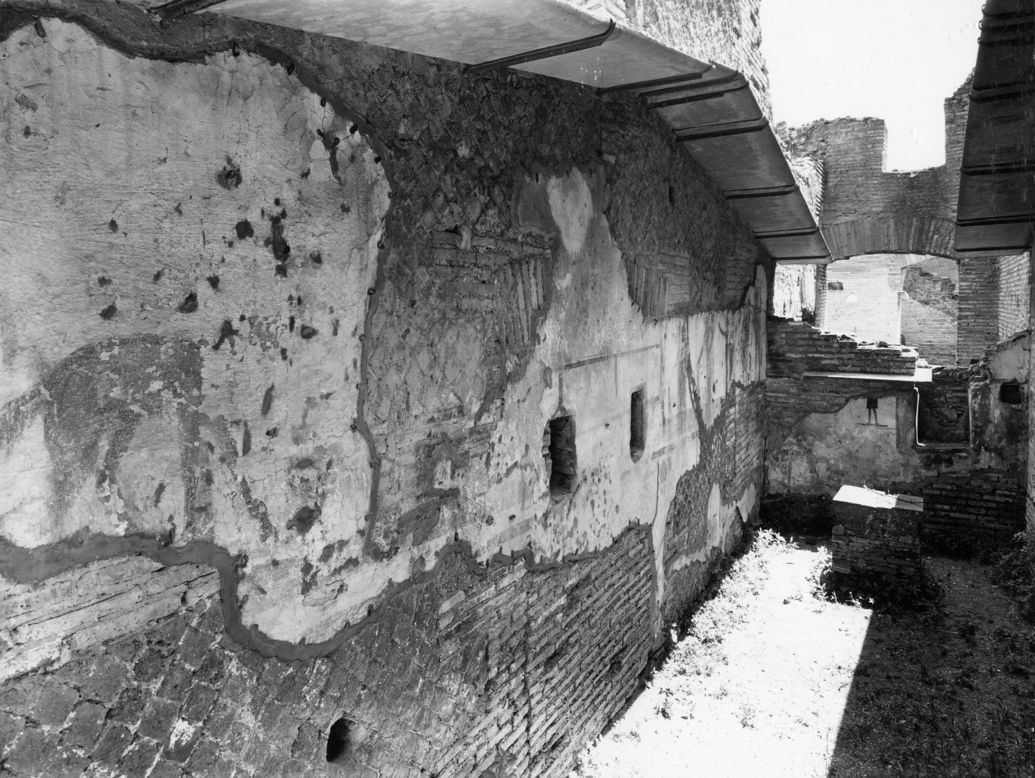
The shrine seen from the north-west. To the left is a horse, behind that two niches (blocked windows), and on the back part the row of figures.
On the back wall is the lower part of a figure, to the left of two niches and behind a masonry altar. Photo: ICCD E040770.
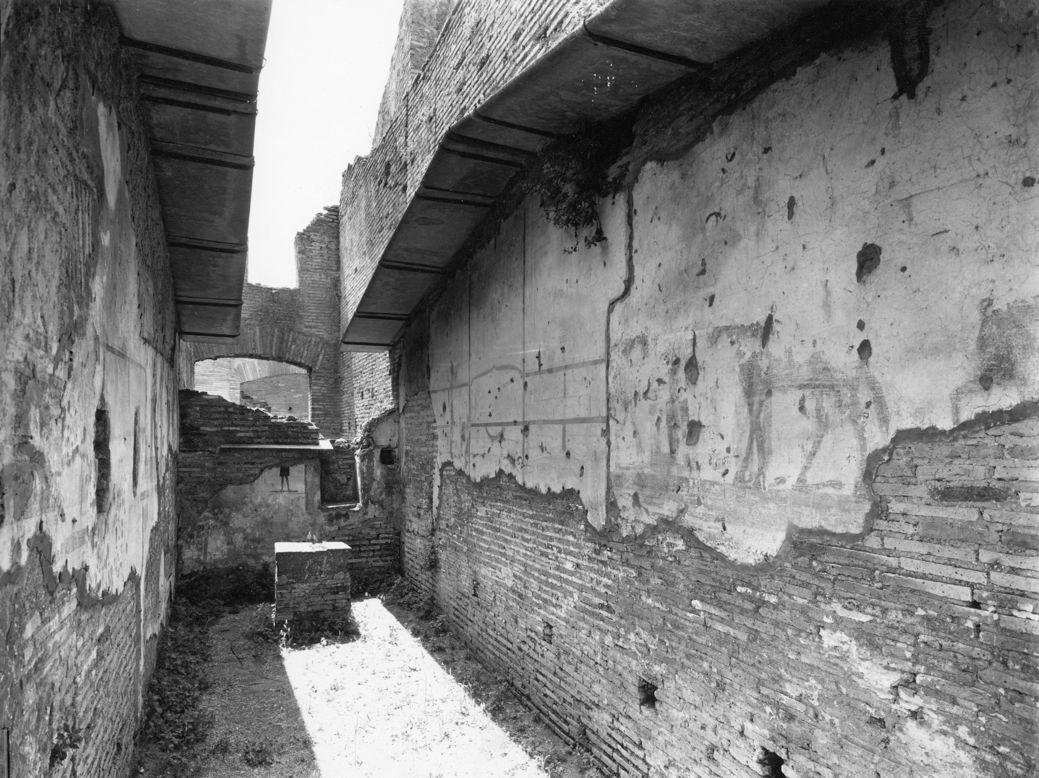
The shrine seen from the north-east. To the right are horses, behind that a groove for a wooden partition,
and on the back part paintings of layer 2. At the far end was the painting of Silvanus. Photo: ICCD E040769.
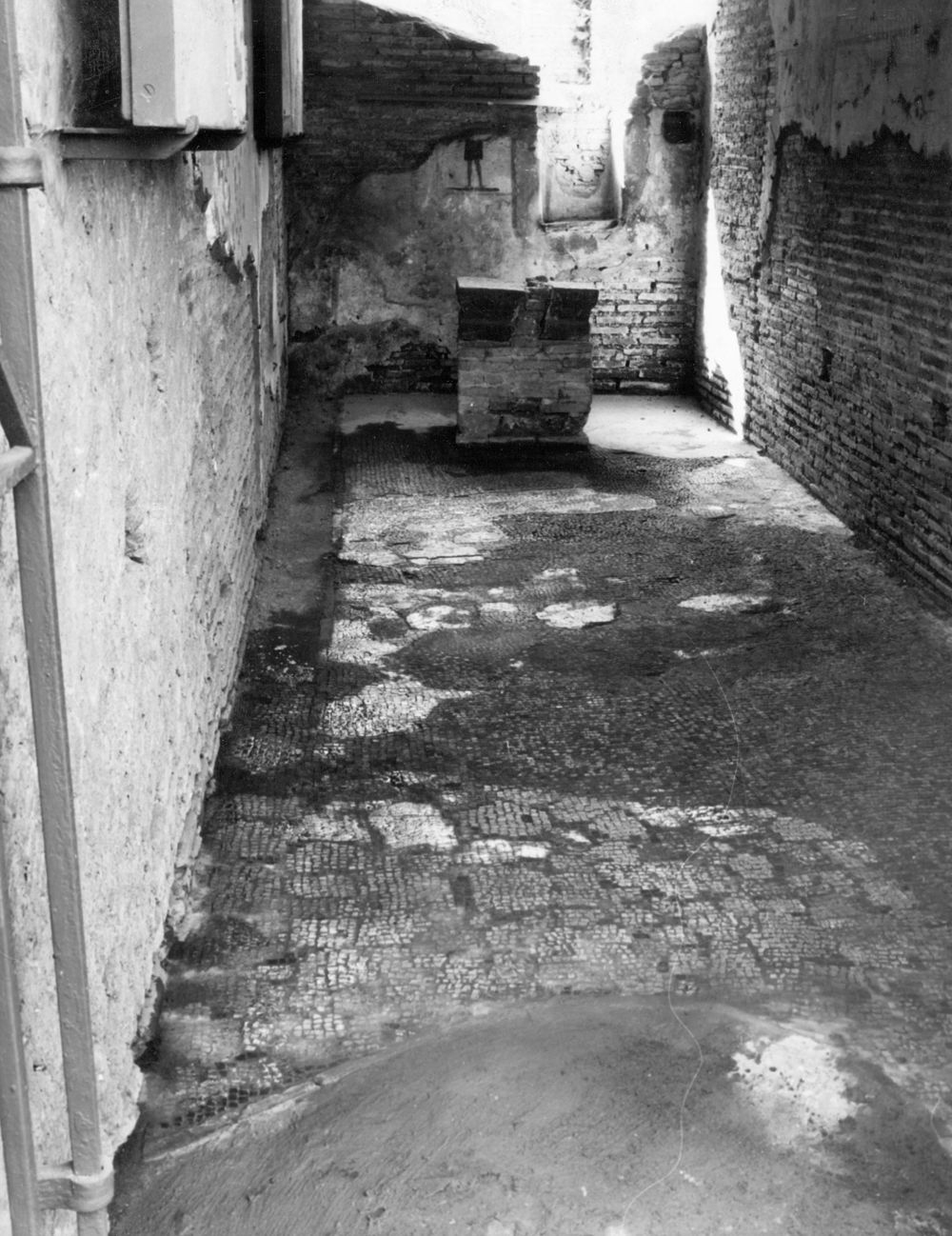
The back part of the shrine seen from the north. Photo: ICCD N015434.
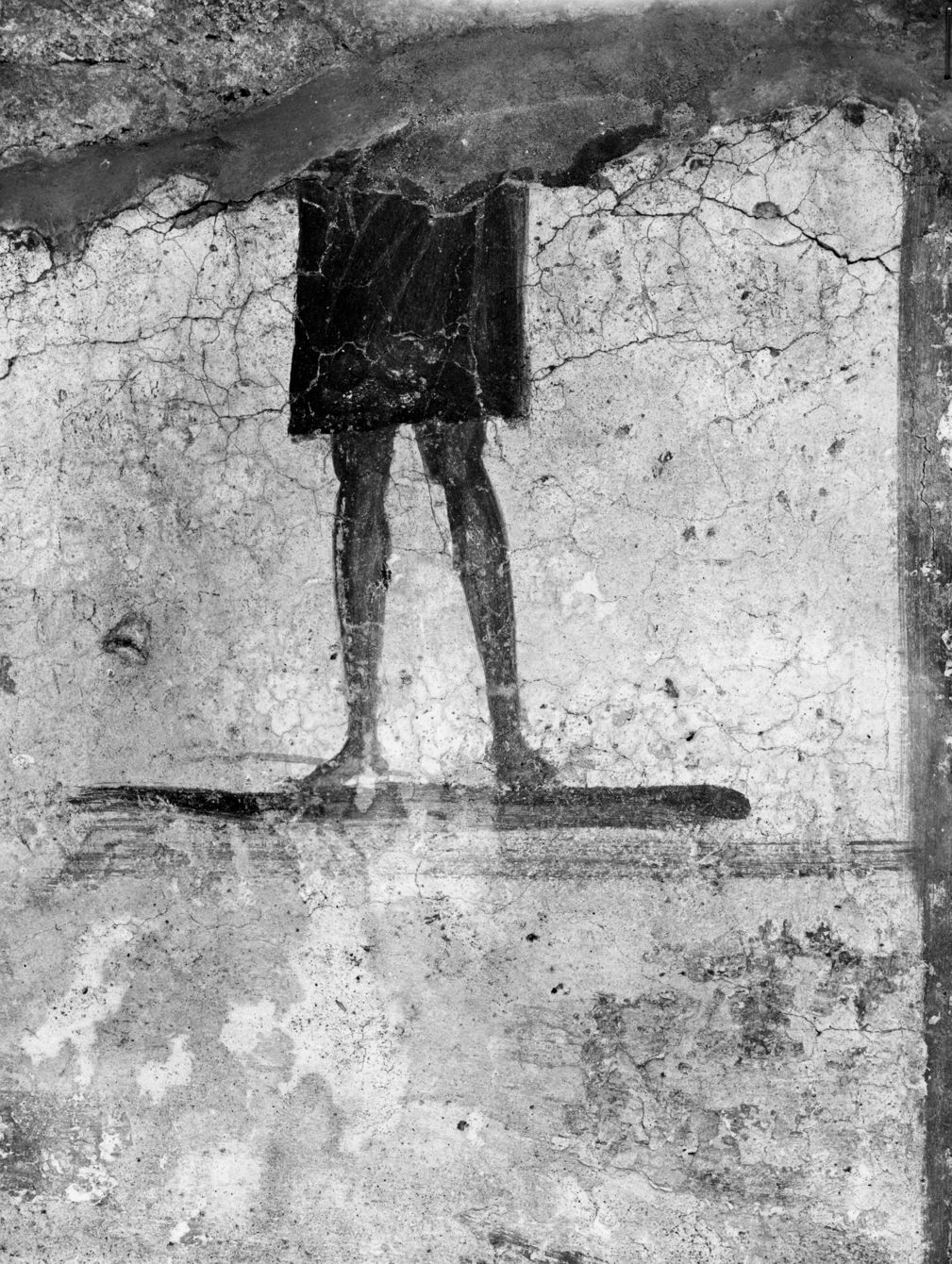
Detail of the figure on the back wall. Photo: ICCD E040756.
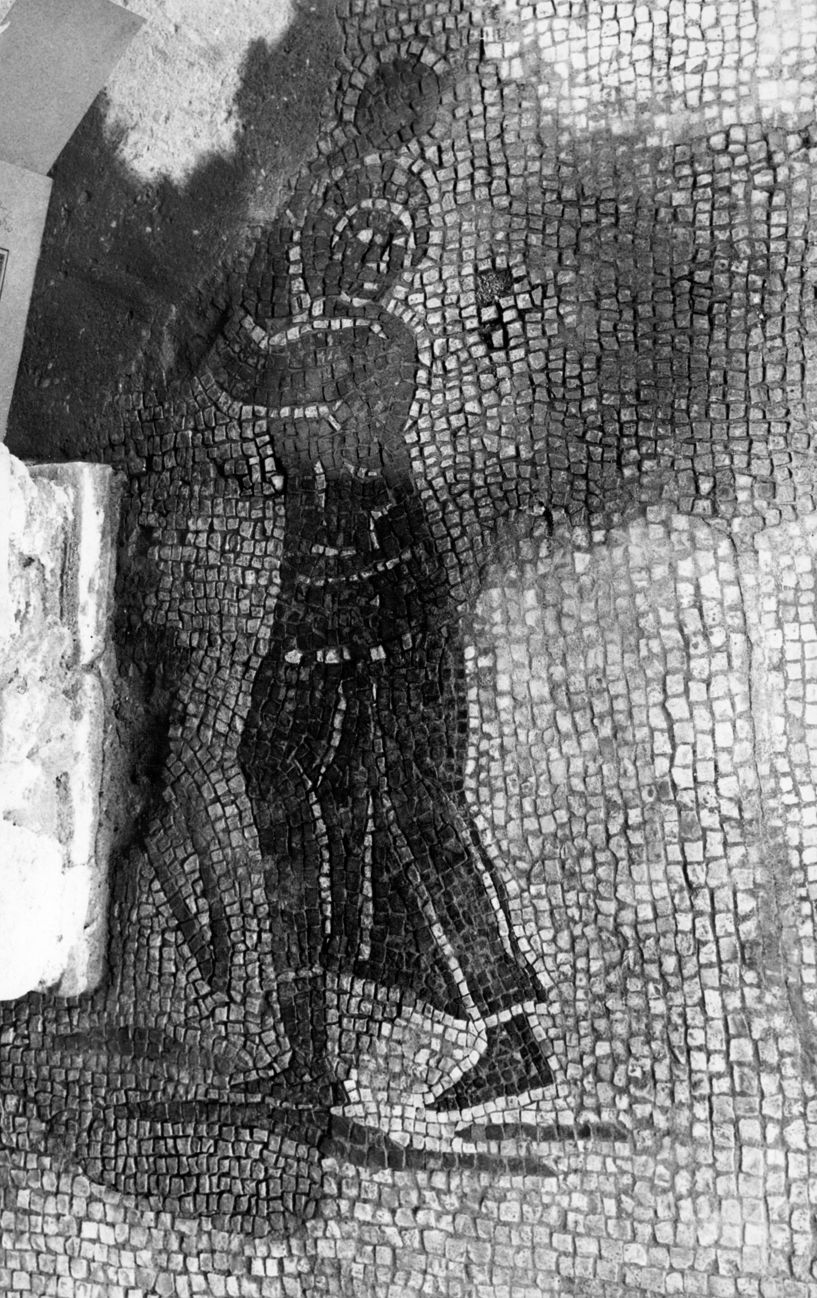
The mosaic of the popa in front of the altar. Photo: ICCD N015443.
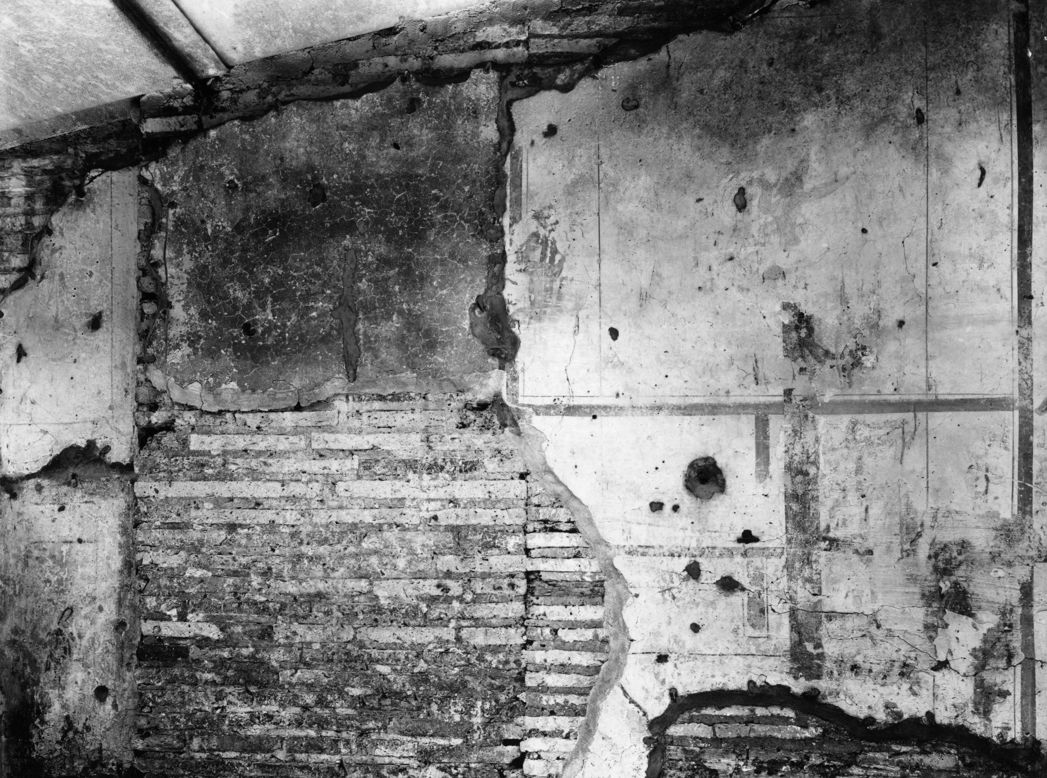
The back part of the west wall, with paintings belonging to layer 2. The painting of Silvanus was in the lower left part and is now in the storage rooms.
At the far right are the remains of a figure belonging to layers 3-4 (the Emperor?). Photo: ICCD E040752.
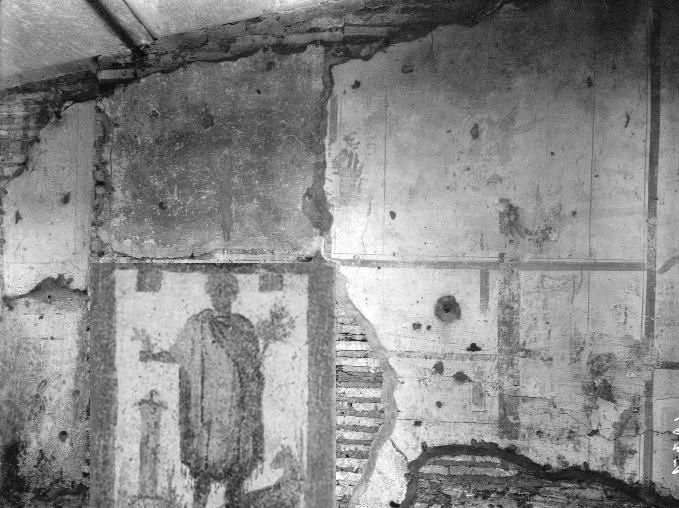
The same photo, but with the painting of Silvanus inserted with the help of the computer.
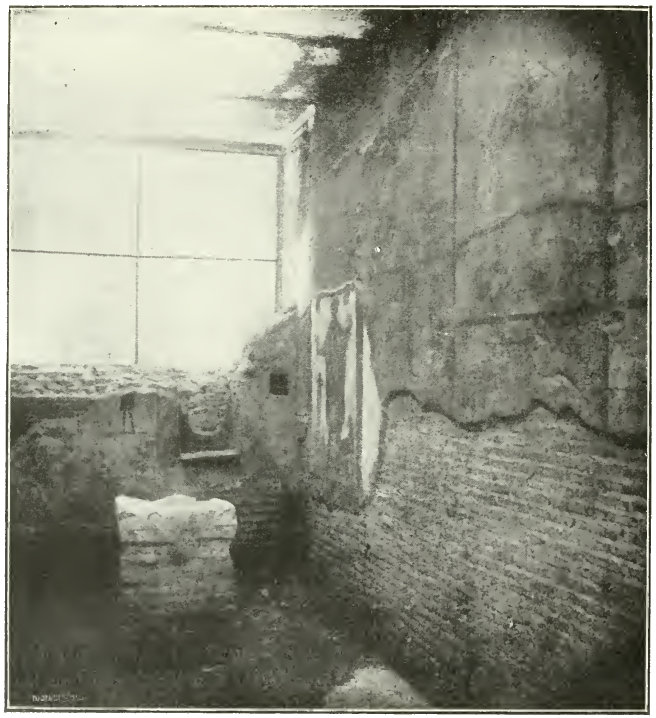
The only clear photo of the painting in situ. NSc 1915, p. 246 fig. 4.
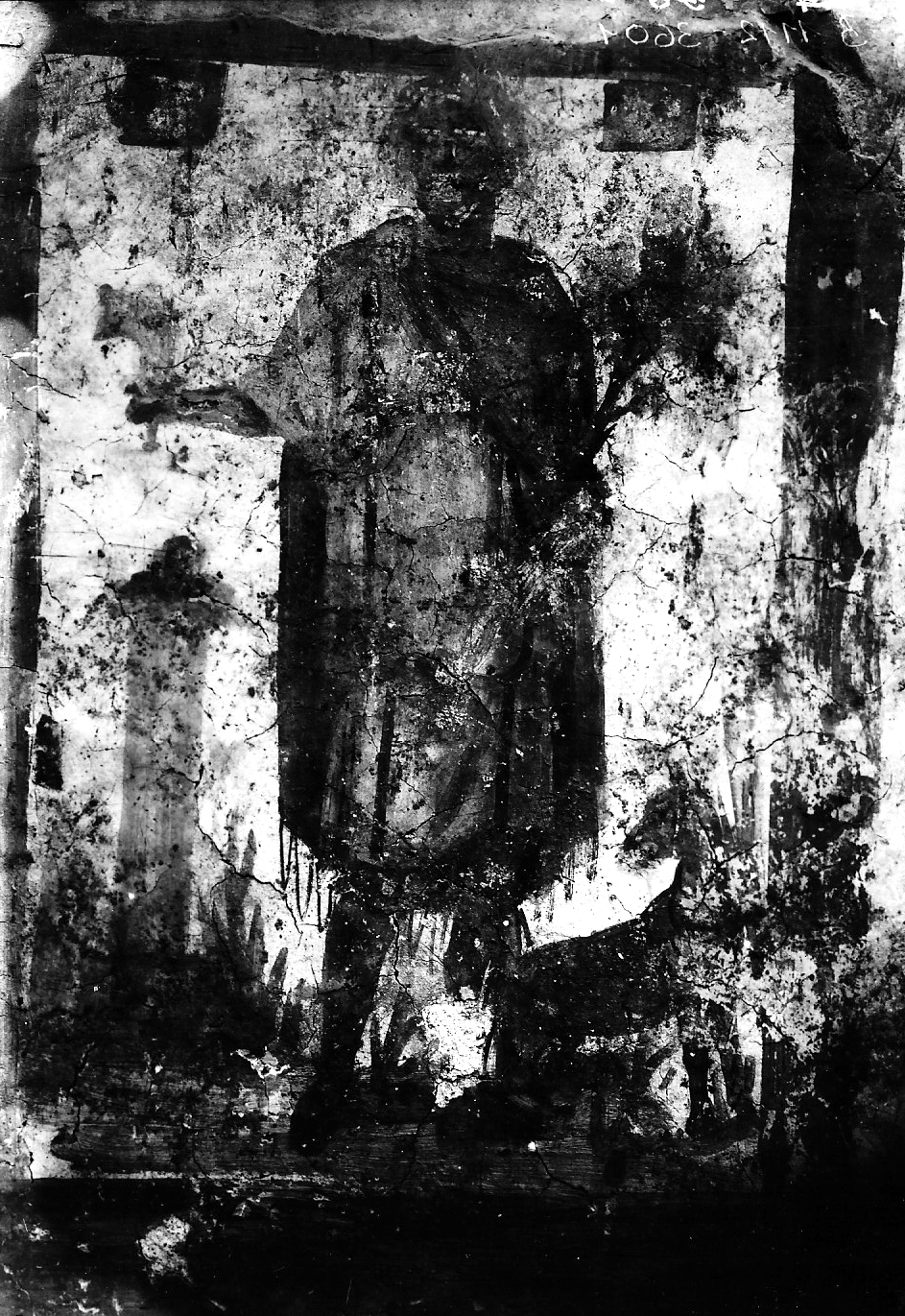
The painting of Silvanus on an old photo, perhaps in situ. Some bright spots may be remains of gilding on the deity and the dog,
reportedly a wide diagonal band on the clothes, on the hair, eyebrows, lips and hands. Parco Archeologico di Ostia, neg. B1112.
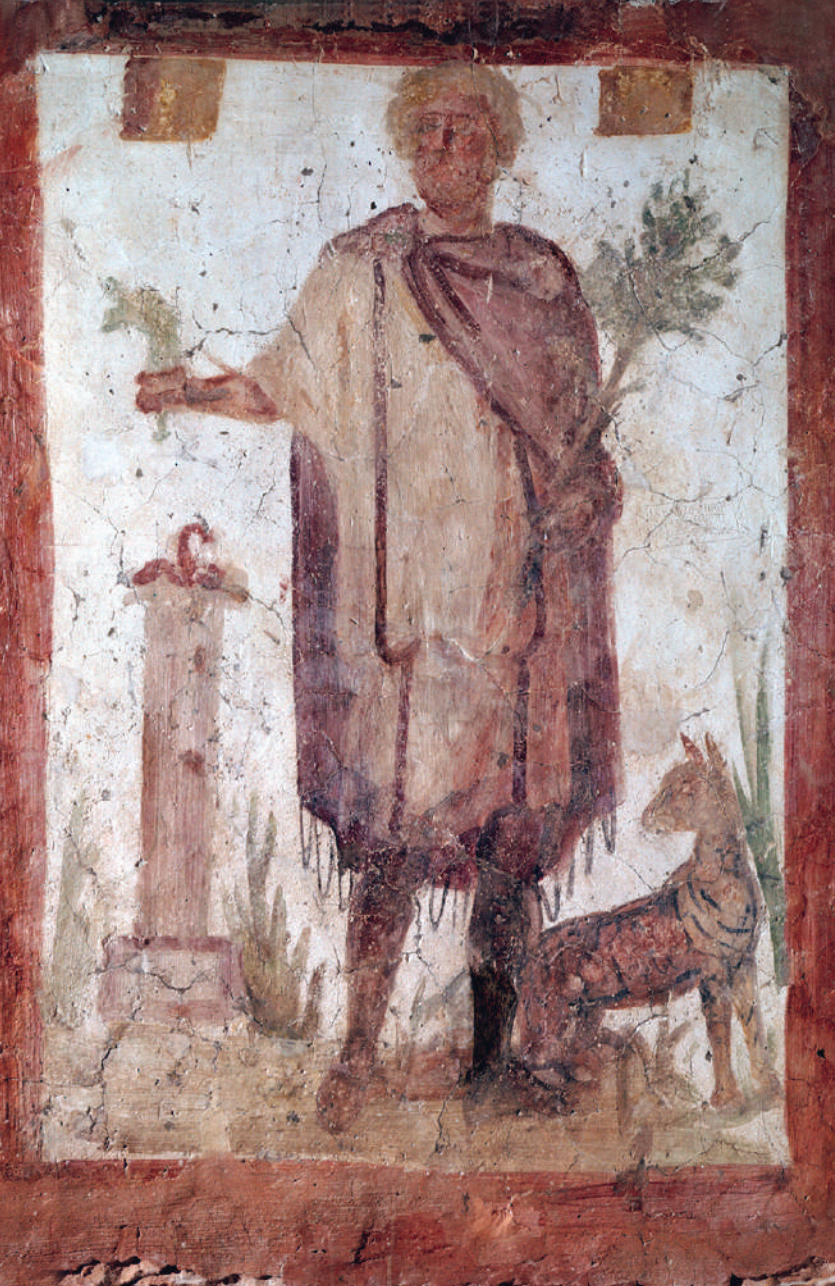
The painting of Silvanus. Photo: Parco Archeologico di Ostia.
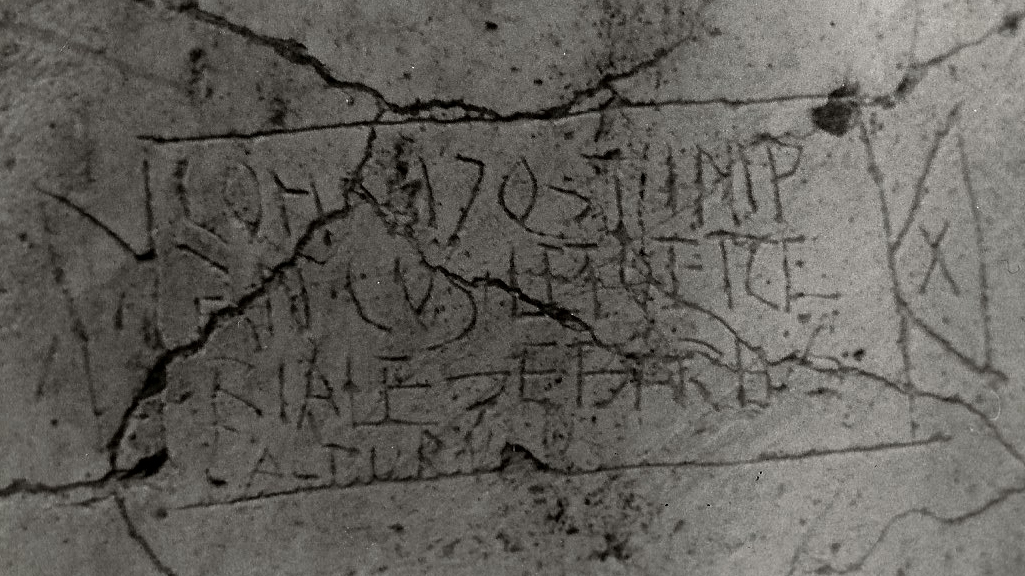
The graffito next to Silvanus. Photo: Jan Theo Bakker.
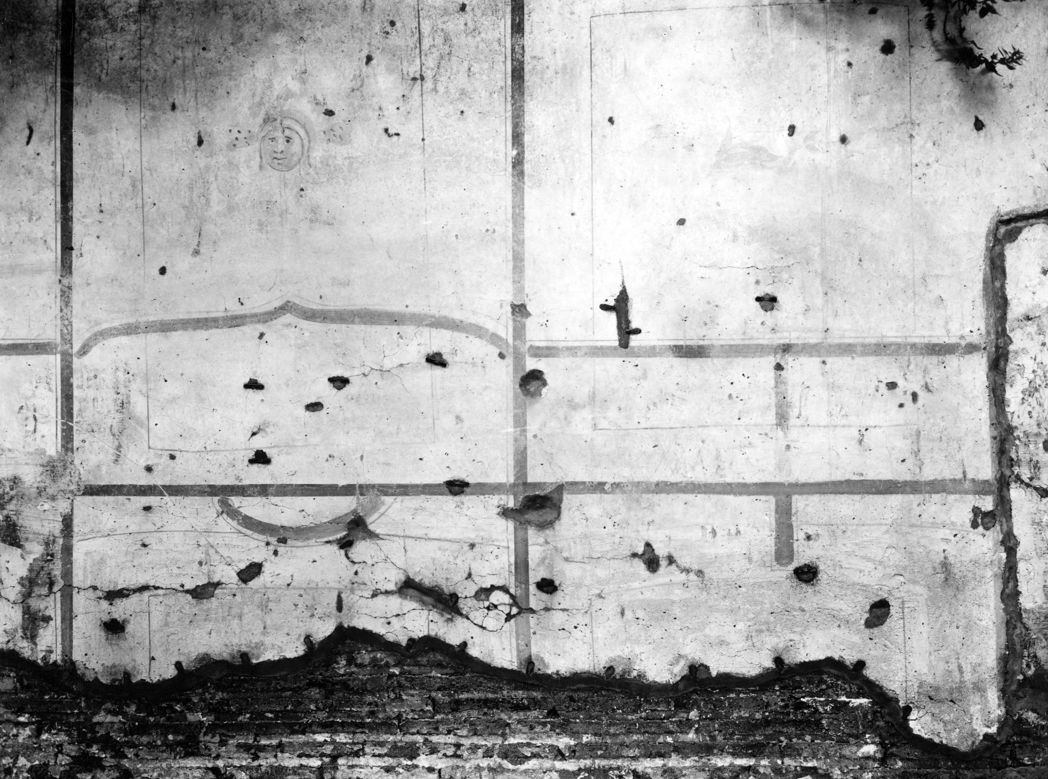
The paintings of layer 2 on the west wall. Photo: ICCD E040773.
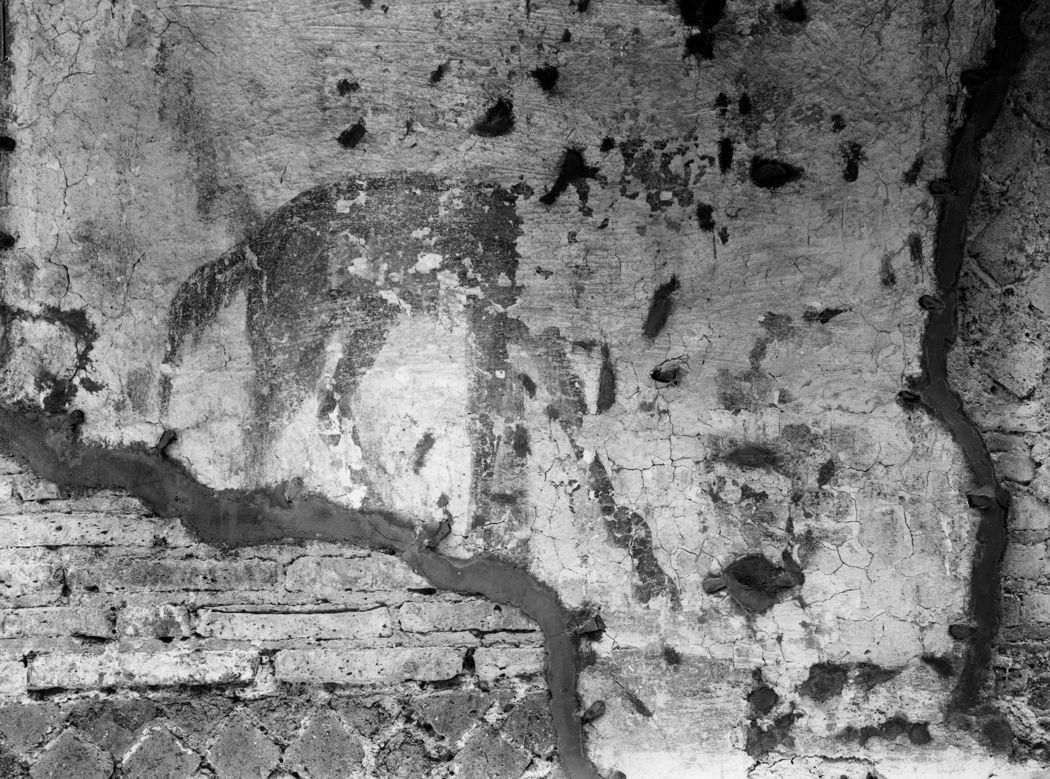
The remains of a horse on the east wall. To the right was probably a Dioscure. Photo: ICCD E040771.
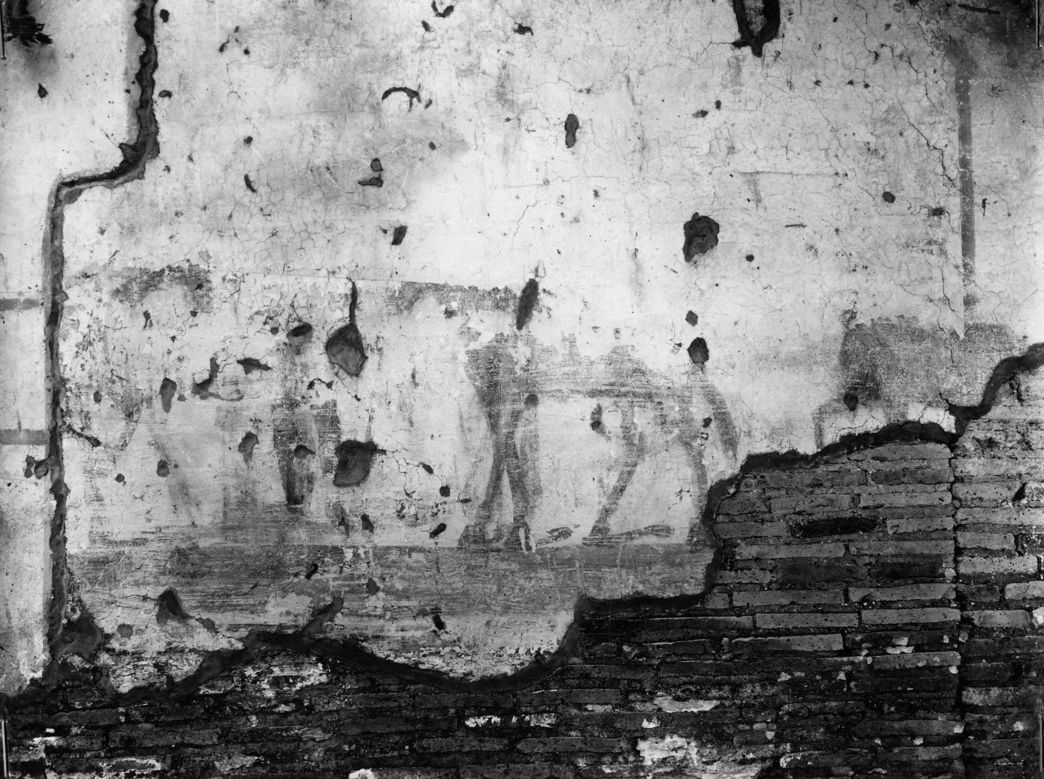
Remains on the front part of the west wall. From right to left: a horse (head lost), a horse, the lower part of a Dioscure,
the front part of a horse (apparently continued on a wooden partition). Photo: ICCD E040772.

The figures as they appeared during the First World War (layer 5). To the right of a niche (a blocked window) are Augustus, Harpocrates,
and an unidentified figure. Note the right arm of Isis (layers 3-4) behind the last figure. Photo: Parco Archeologico di Ostia.
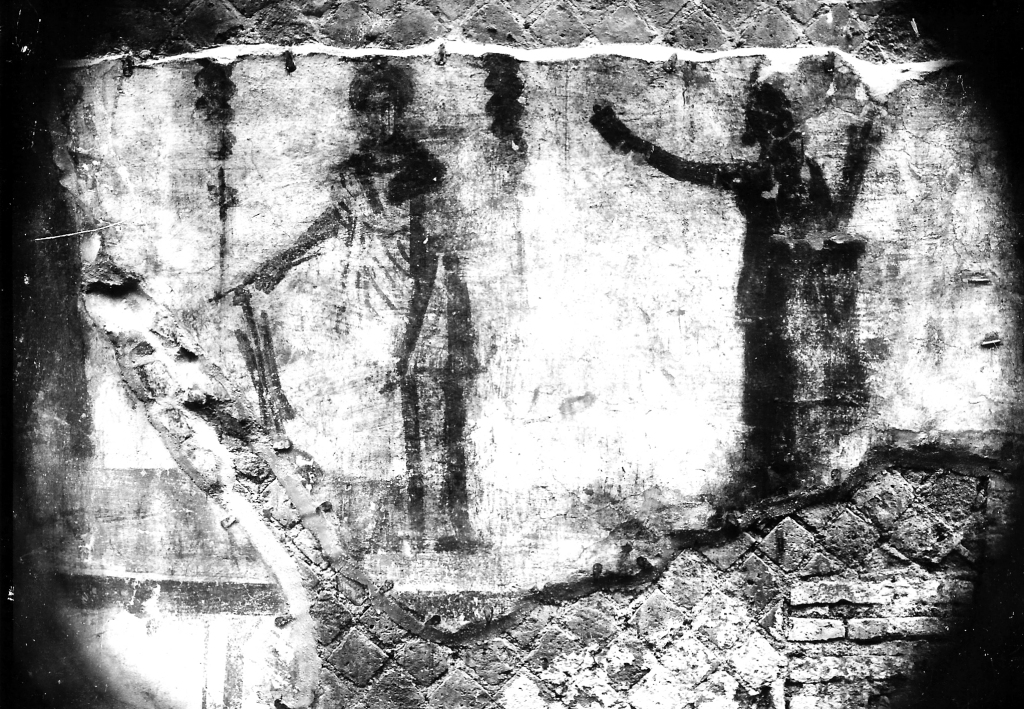
The figures as they appeared during the First World War (layer 5). This is the central part, with Fortuna between two torches and Annona.
Photo: Parco Archeologico di Ostia.
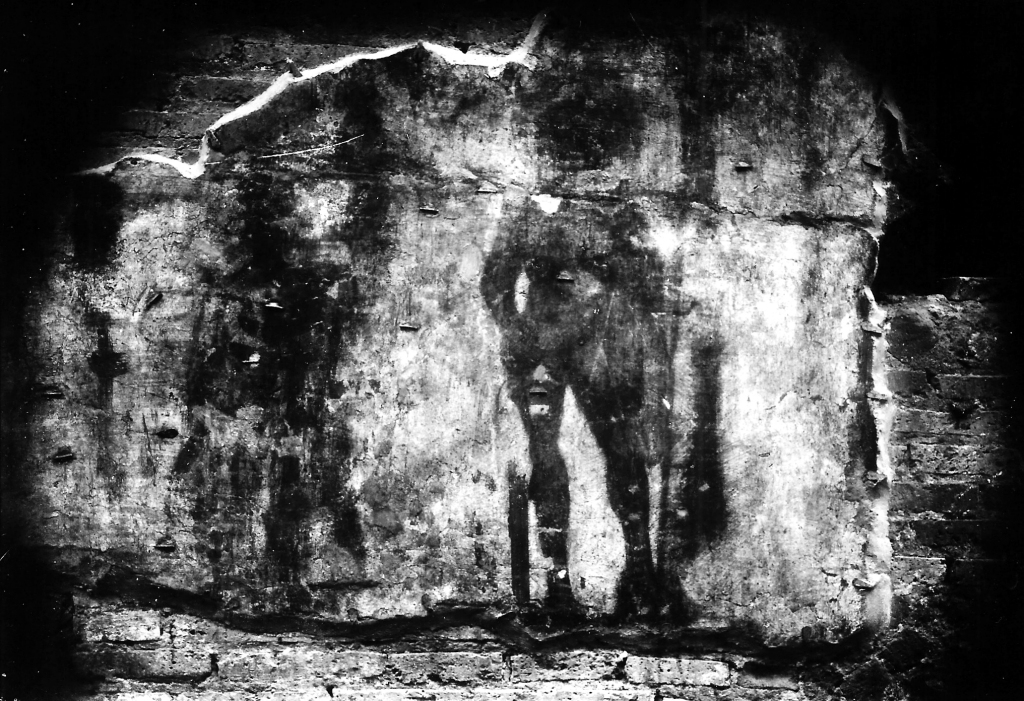
The figures as they appeared during the First World War (layer 5). This is the right part, with an unidentified figure (Genius?) and Alexander the Great.
Photo: Parco Archeologico di Ostia.
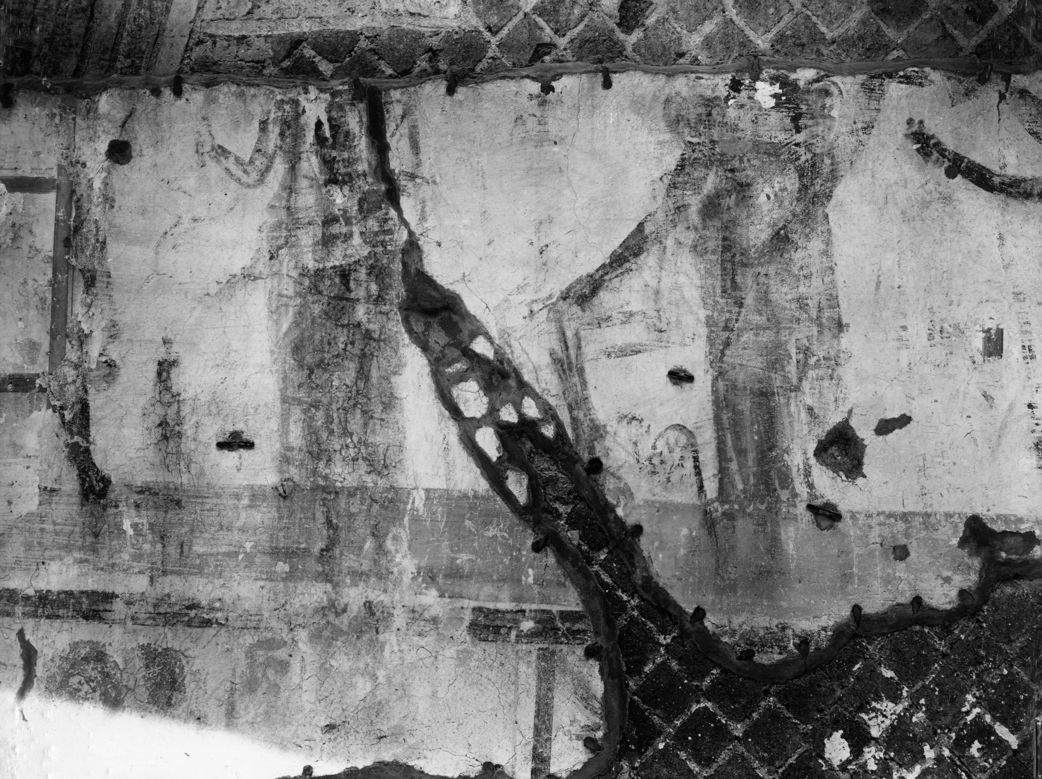
The figures as they appeared after the almost complete disappearance of layer 5: Augustus, Harpocrates, Isis and Fortuna.
The head of the Fortuna of layer 5 can still be seen on the right shoulder of the last figure. Photo: ICCD E040766.
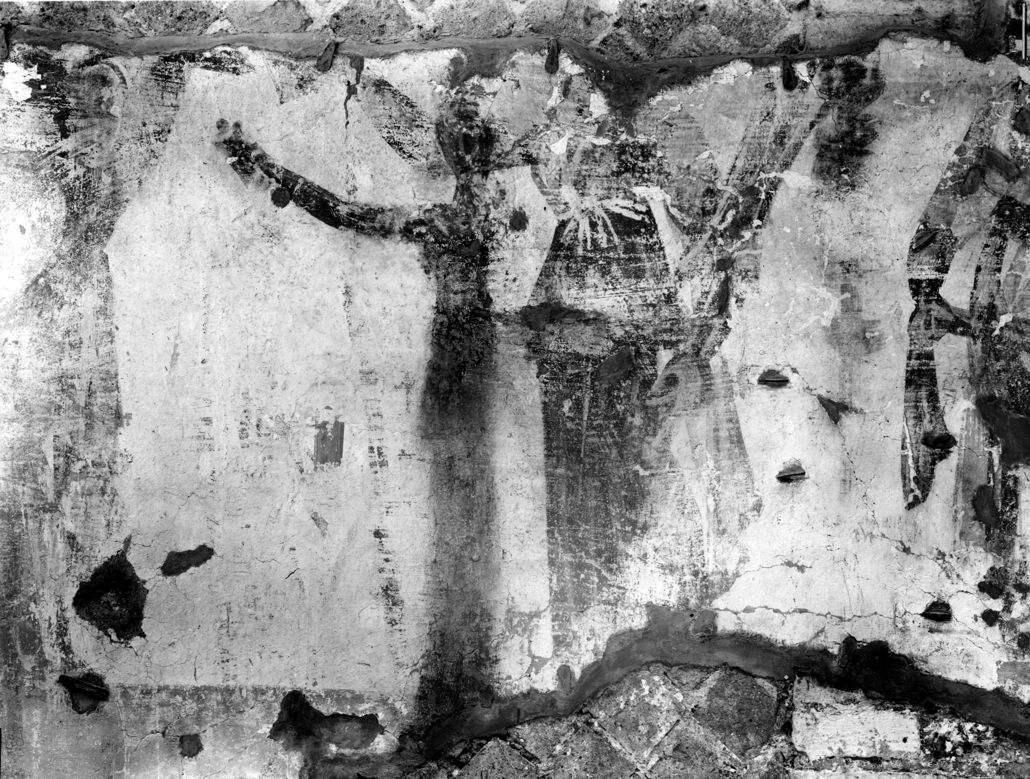
The figures as they appeared after the almost complete disappearance of layer 5: Annona.
Half of the Annona of layer 5 can still be seen. Photo: ICCD E040757.
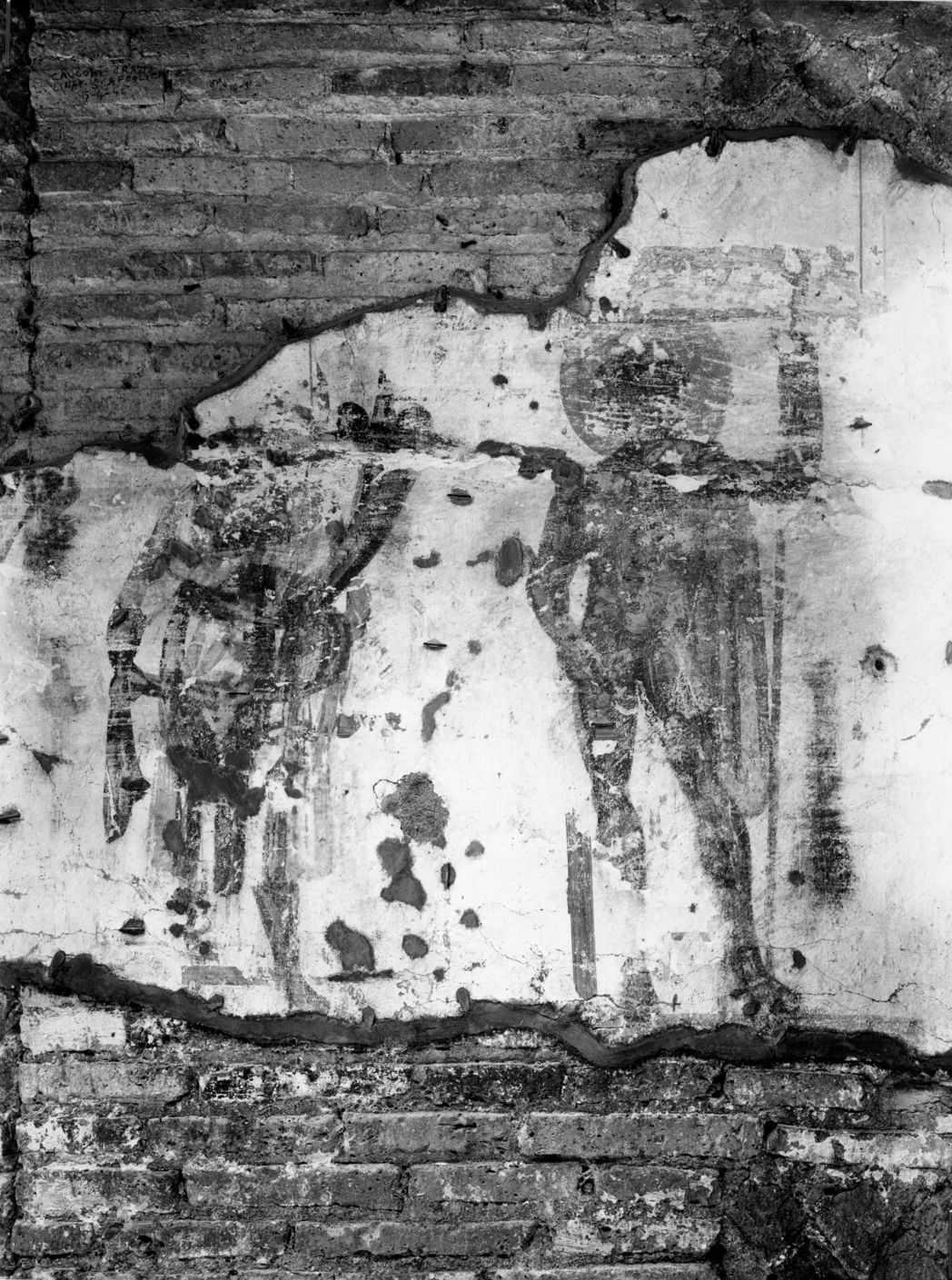
The figures as they appeared after the almost complete disappearance of layer 5: a Genius (?) and Alexander the Great.
Photo: ICCD E040761.
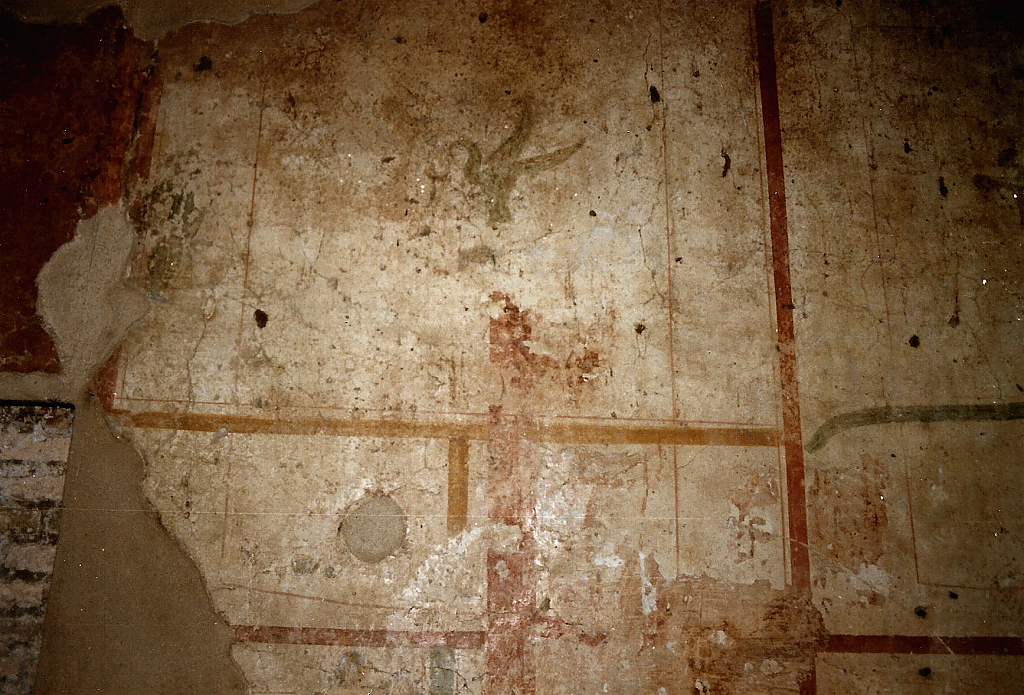
The paintings as they appear today: layer 2 on the west wall.
Photo: Jan Theo Bakker.
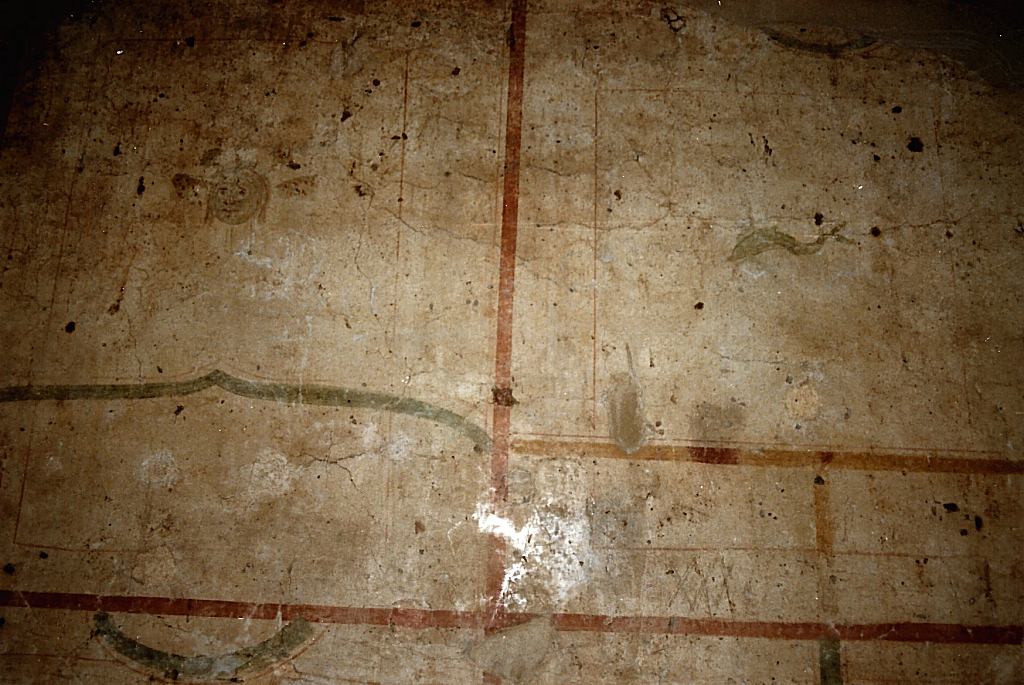
The paintings as they appear today: layer 2 on the west wall.
Photo: Jan Theo Bakker.
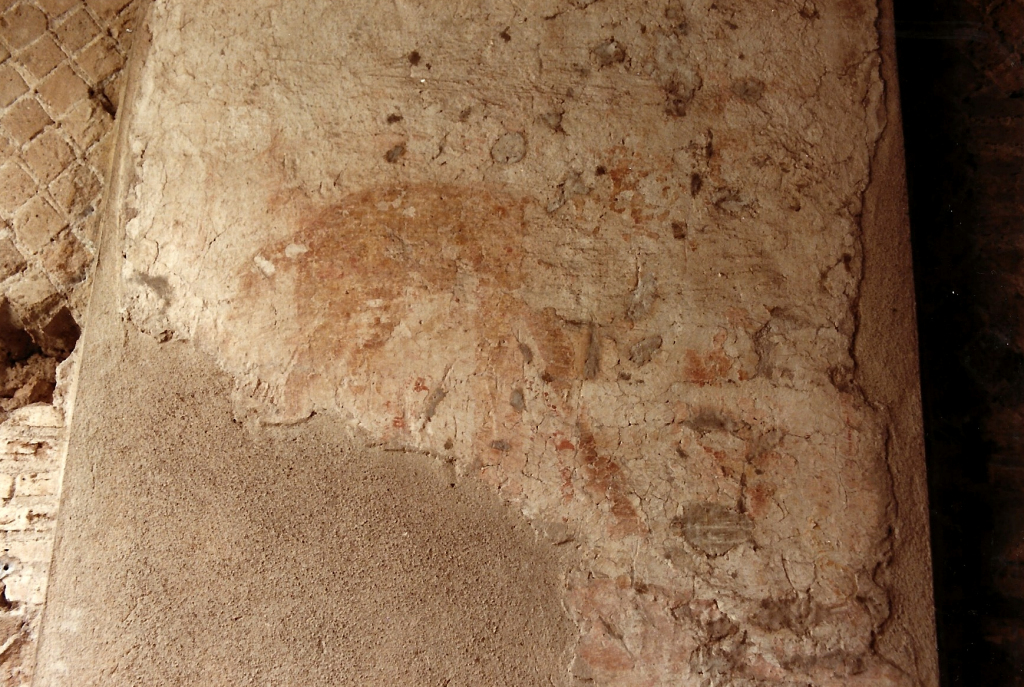
The paintings as they appear today: the horse on the east wall.
Photo: Jan Theo Bakker.
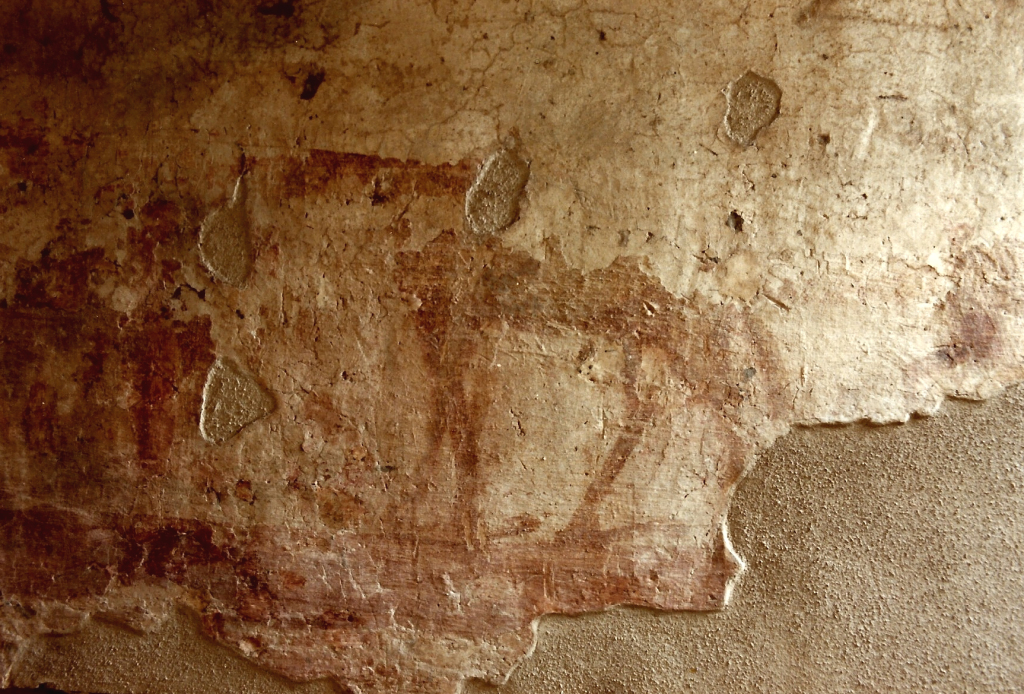
The paintings as they appear today: the horse on the west wall.
Photo: Jan Theo Bakker.
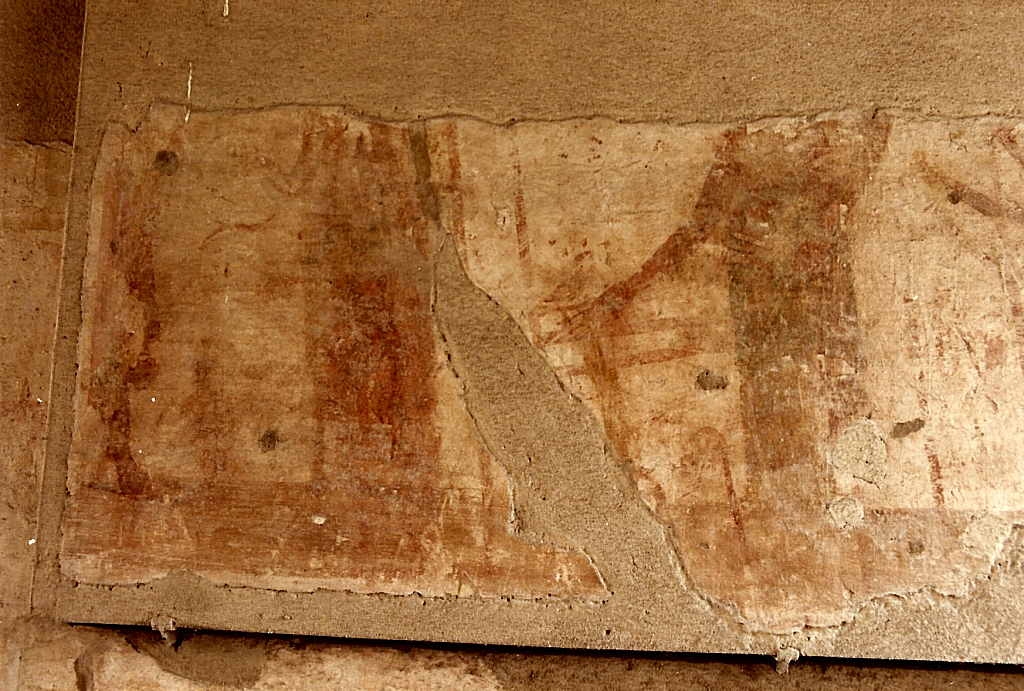
The paintings as they appear today: the left part of the row of figures.
Photo: Jan Theo Bakker.
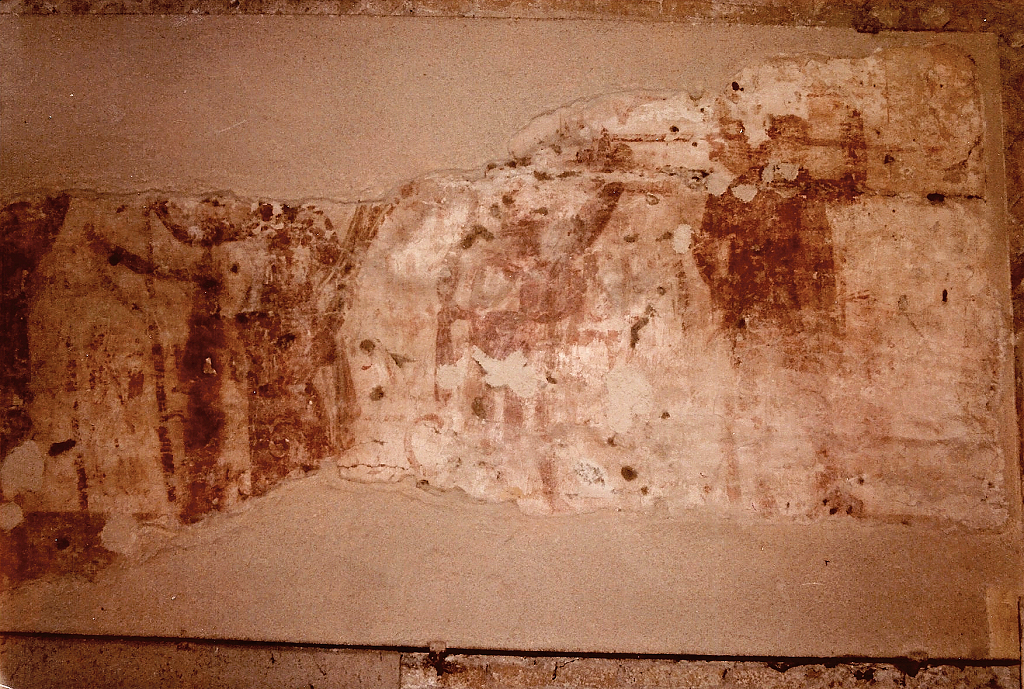
The paintings as they appear today: the right part of the row of figures.
Photo: Jan Theo Bakker.
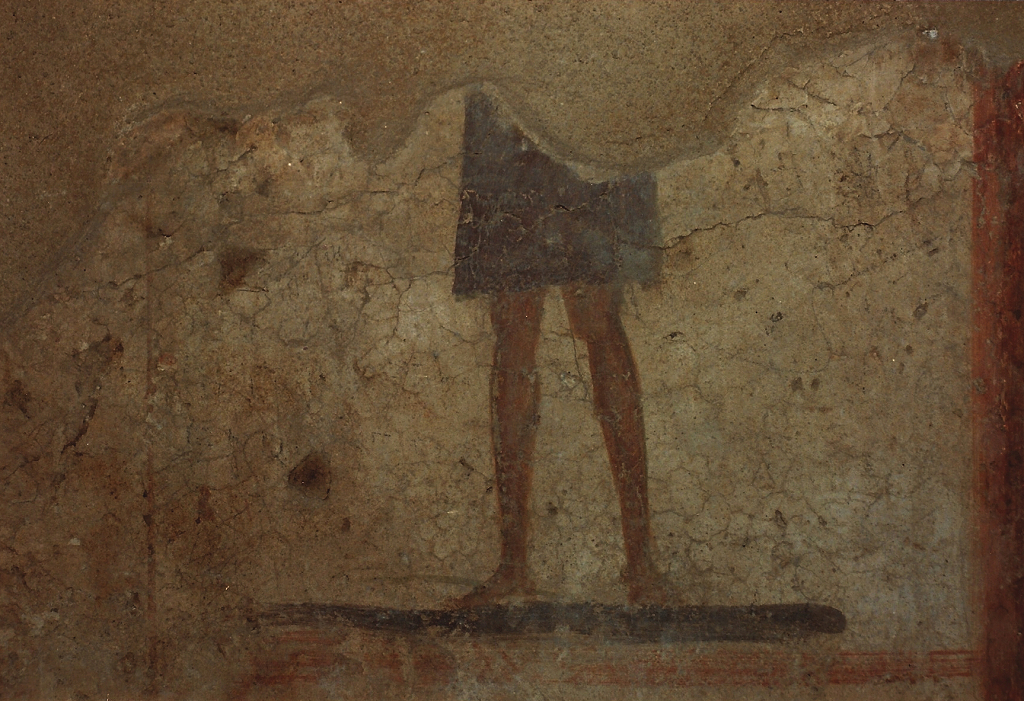
The paintings as they appear today: the figure on the back wall.
Photo: Jan Theo Bakker.
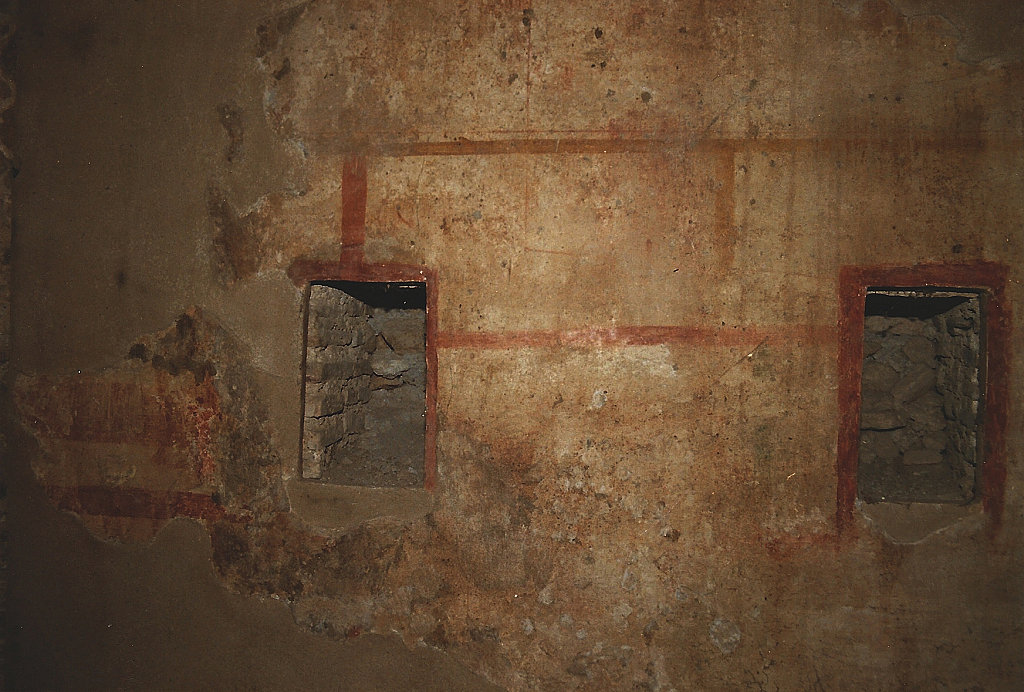
The paintings as they appear today: the niches in the east wall.
Photo: Jan Theo Bakker.
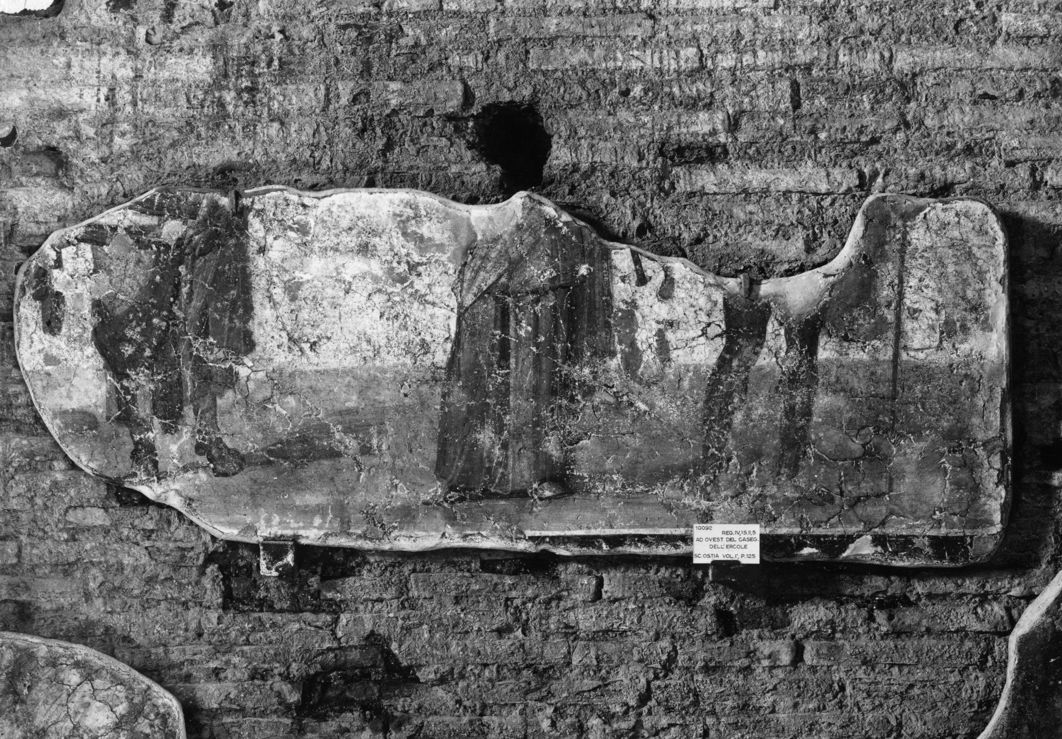
The parallel for the row of figures from the House of Hercules. Photo: ICCD E040753.
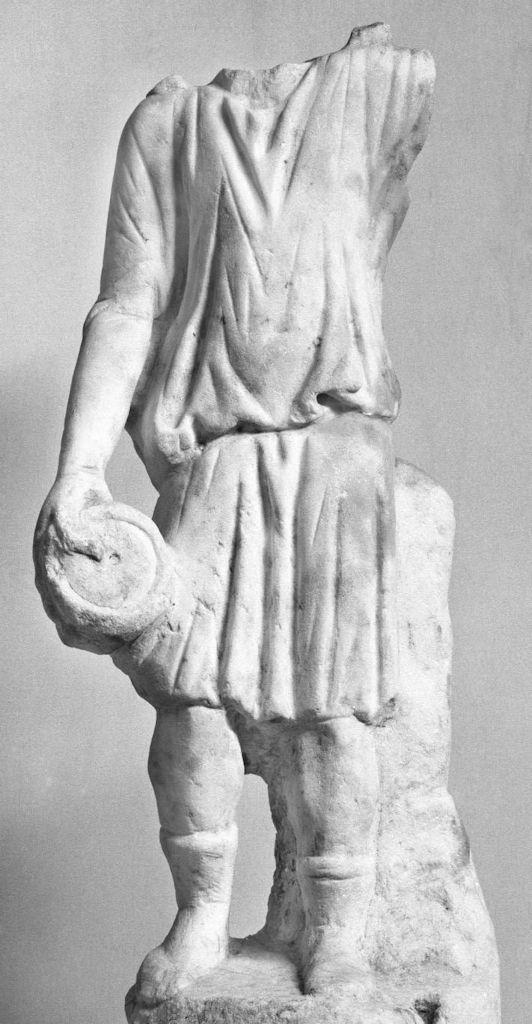
The marble statuette of a Lar. Photo: Arachne.